When Rob tested the Tesla Model 3 Standard Range Plus (as it was known then) two years ago, he had mixed feelings. Some glitches occurred with the test car, the range was a problem, and build quality was a little lacking.
But that was an American-built Model 3. This year, Tesla has given us a Chinese-built Model 3 Long Range for a 3-week drive over the 2021-2022 Christmas period.
Will having the car sourced from another country make it better? Will it reach its WLTP rating of 614Km?
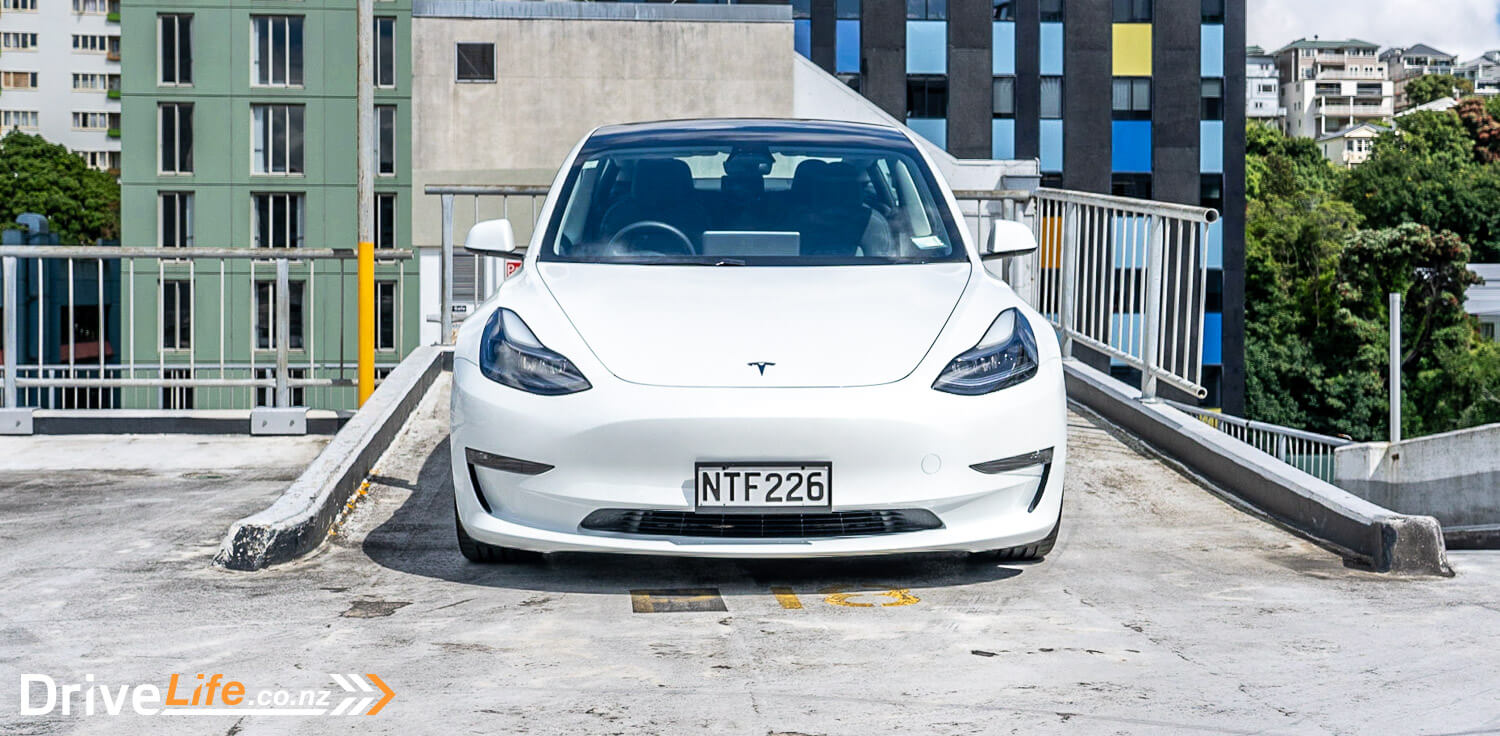
What We Like and Dislike About The 2021 Tesla Model 3 Long Range
| What we like | What we don’t like |
| Absence of road, wind noise Interior space Minimalism Boot space Get in and drive functionality Effortless driving Autosteer is brilliant Relative value for money | Heat inside car Traffic sign recognition Aircon struggles No heads-up display Water runs into the boot |
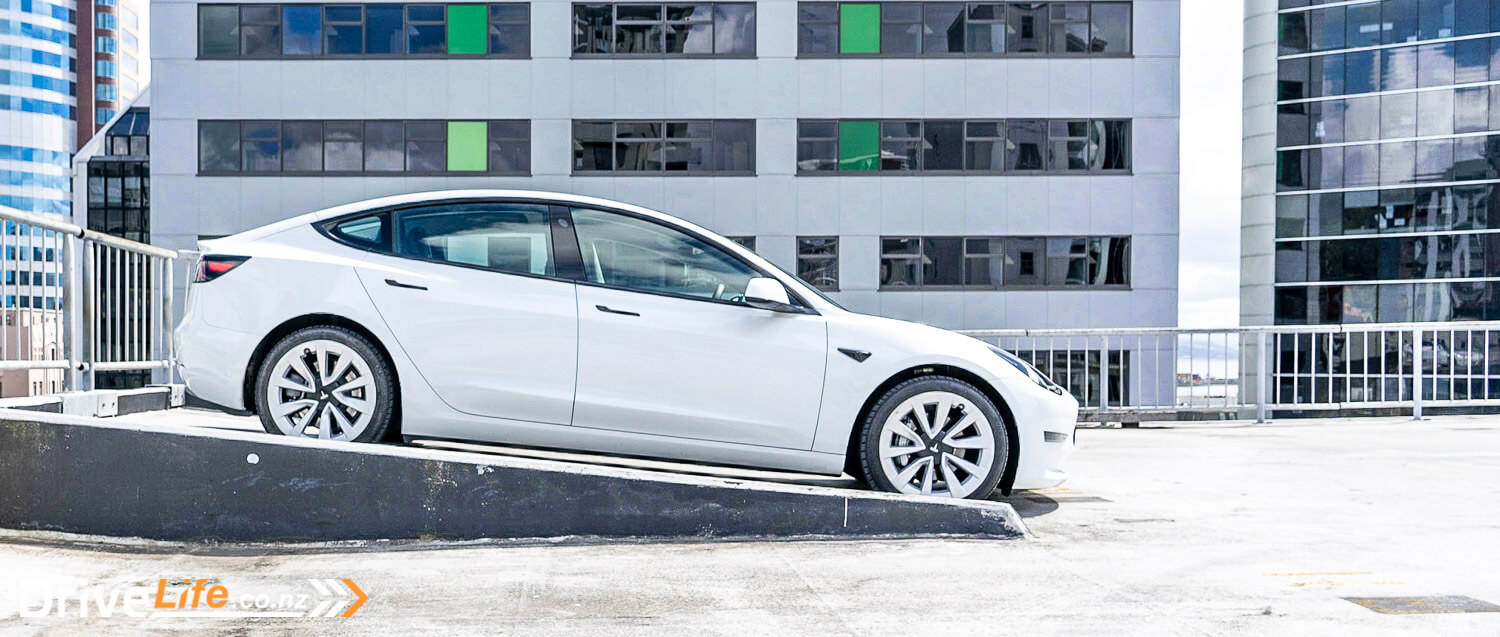
What’s In The 2021 Tesla Model 3 Range?
There are three models in the Model 3 range; The base is called the Rear-Wheel Drive and has a single electric motor, obviously driving the rear wheels. It has a WLTP range of 491Km and can get to 100km/h in 6.1 seconds. The cost of this model is $66,900, so it easily qualifies for the Clean Car Scheme subsidy of $8,625. The drive-away price (pre-subsidy) is $68,923, making it a tad over $60K after the subsidy.
Next up is the Model 3 Long Range (tested); it is a dual motor (so all-wheel drive), has a WLTP range of 614Km and gets to 100km/h in 4.4 seconds. The cost of this model is $82,900, with a drive-away price of $84,932. The extra costs are outlined below.
Last up is the Performance model. It’s still dual-motor of course but it will get to 100km/h in 3.3 seconds, has a WLTP range of 567Km and costs $95,900, with a drive-away price of $97,932.
Updates over the previous model we tested last year include:
EXTERIOR UPDATES
Trim Updates
- Satin black side repeaters, door handles and brightwork
Wheel/Tire Updates
- More efficient tyres across the range
- Updated 18/19” Sport Wheels
- Model 3 Performance with new 20” Uberturbine wheels
Power trunk
- Opens at the touch of a button on the trunk itself or from the touchscreen or the Tesla app.
INTERIOR UPDATES
Updated Trim
- Matte black finish replaces the gloss ‘piano’ black finish,
- Satin black sill plates
- Graphite finish seat controls
- Metalised scroll wheels on steering,
Sunvisors
- Magnetic closure to snap back into place
Redesigned centre console
- Fixed inductive charging mats for two smartphones
- Updated front compartment with sliding lid
USB ports
- Two additional high-powered USB-C ports for high-speed device charging
- Plus an additional USB-A port in the glove compartment to use for storage devices for Sentry Mode and Dash Cam footage
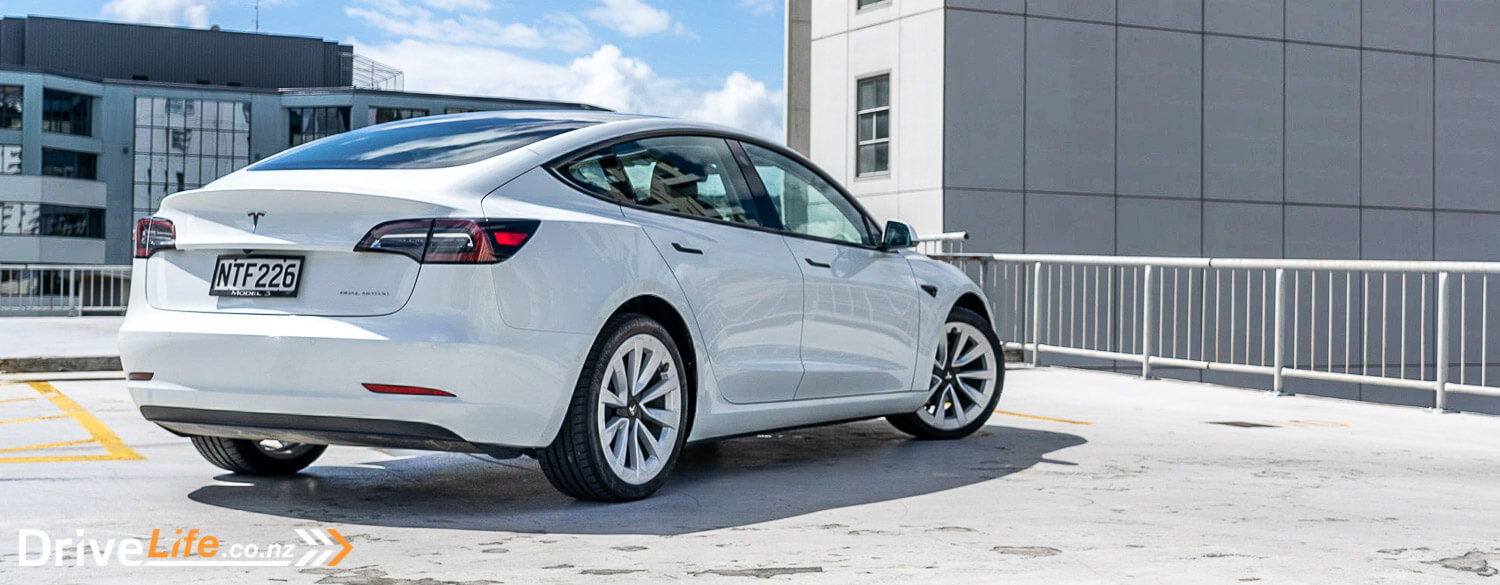
2021 Tesla Model 3 Standard Equipment Highlights
- Glass roof with ultraviolet and infrared protection
- 15” centre display
- SatNav
- Dual Qi wireless phone charging
- All vegan interior
- Power front seats with memory for the driver through driver profiles
- Heated front and rear seats
- Heated steering wheel
- Power folding and heated, auto-dimming exterior mirrors
- 4xUSB-C ports
- Caraoke
- Blind-spot monitoring
- Front collision warning
- Side collision warning
- Emergency lane departure avoidance and correction
- Obstacle aware acceleration
- LED daytime running lights
- Sentry Mode
- Cabin Overheat Protection
- In-app vehicle location monitoring
- 18” aero wheels
Options for the base model include 19” Sport wheels at $2,500, and a white interior for $1,700.
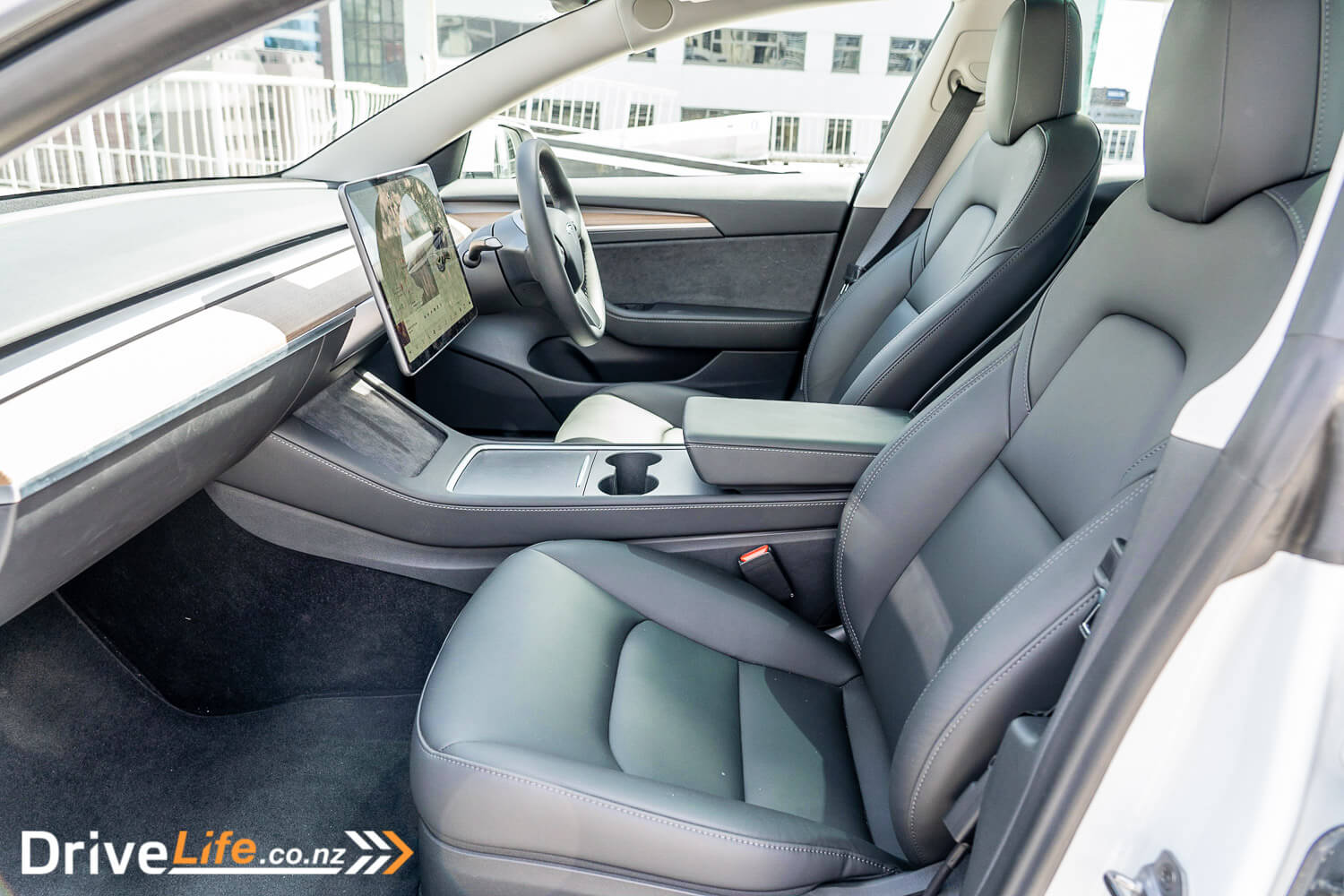
2021 Tesla Model 3 Long Range Additional Equipment/Features
- Premium audio with 13 speakers, 1 subwoofer, 2amps and immersive sound
- Floor mats
- 19” Sport Wheels
2021 Tesla Model 3 Performance Additional Equipment/Features
- 20’’ Uberturbine Wheels
- Performance Brakes
- Carbon fibre spoiler
- Lowered suspension
- Aluminium alloy pedals
- Increased top speed from 233 km/h to 261 km/h
- Track Mode
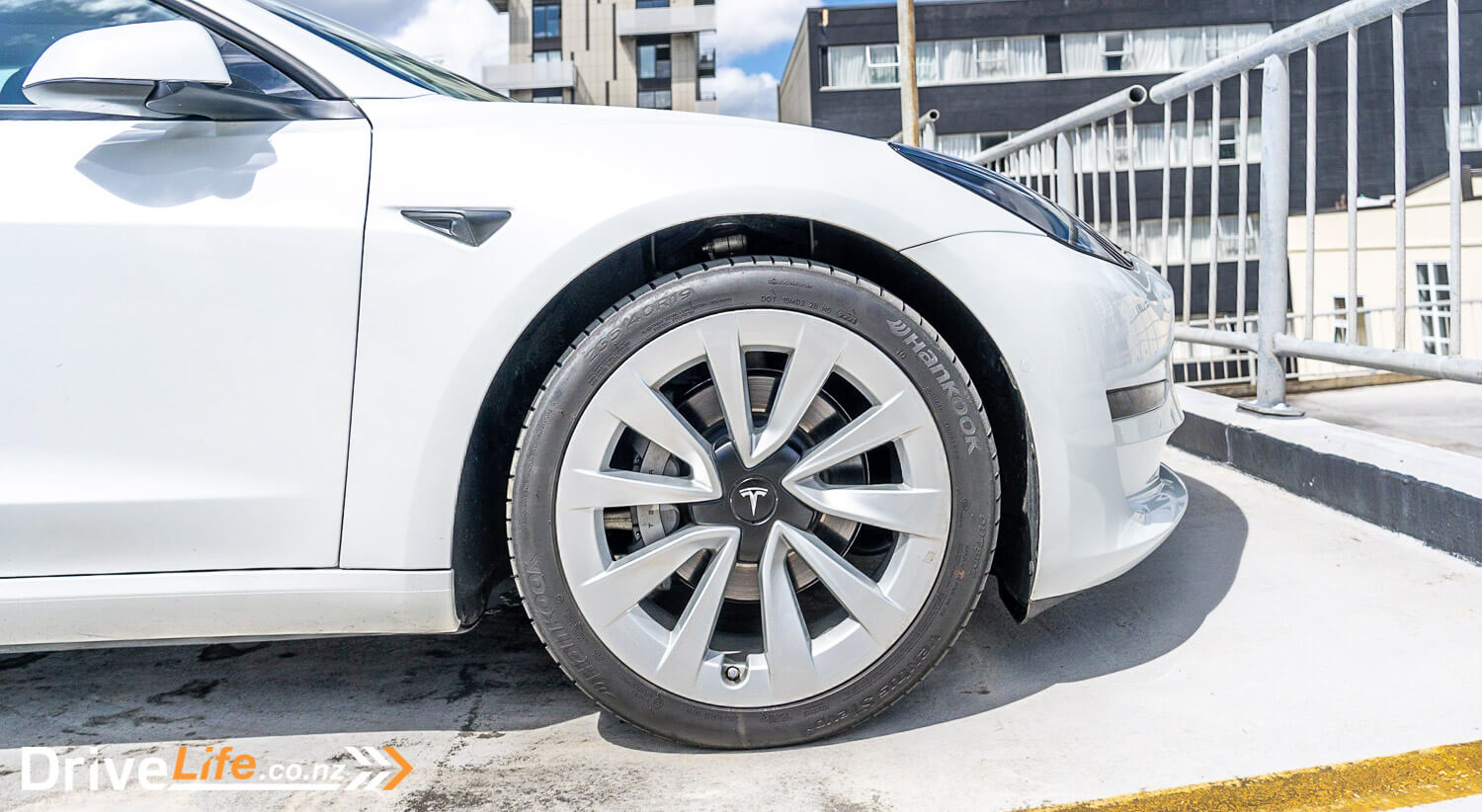
There’s a small range of 5 colours to choose from for your new Model 3. White is standard, while any other colour attracts an additional cost. Solid Black, Midnight Silver Metallic, and Deep Blue Metallic are all $1,700 extra, while Red Multi-Coat is $3,300.
Our review car’s total price was a base of $82,900, then $1,375 for a delivery fee, $400 for an order fee and $257 for registration, for a drive-away price of $84,932.
For a full list of specs and options available for the Tesla Model 3 jump on over to the Tesla New Zealand website.
How Does The 2021 Tesla Model 3 Long Range Compare To Its Competition?
Some people believe if you want a four-door EV in New Zealand, your only choice is Tesla. Well, they’d be right. Let’s be honest; there isn’t much competition for this car. All-wheel-drive, a sedan and with a 75kWh battery pack? It’s in a class of its own.
We’ve thrown in a few random EVs just to give it something to sit with.
| Make/ Model | Battery Capacity kW-hr | Power/ Torque kW/Nm | 0-100km/h seconds | Range (WLTP) Km | Boot Space, litres | Price |
| Hyundai Ioniq 5 Base AWD SUV | 72 | 225/605 | 5.1 | 430 | 537 | $94,990 |
| Mercedes-Benz EQA FWD SUV | 66.5 | 140/375 | 8.9 | 400 | 340 | $85,500 |
| Tesla Model 3 Long Range AWD | 75 | 258/510 | 4.4 | 614 | 561 | $84,932 |
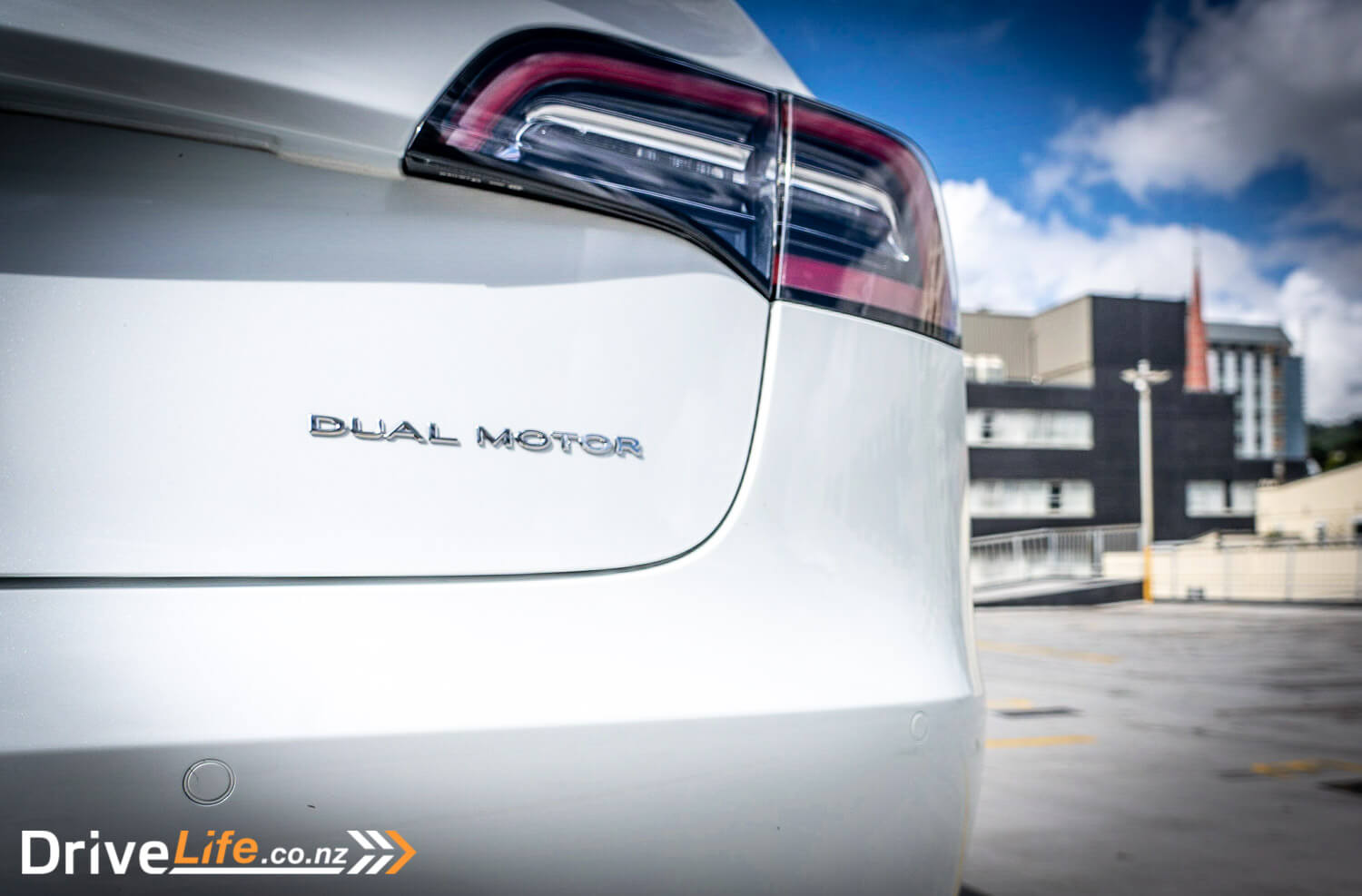
First Impressions Of The 2021 Tesla Model 3 Long Range
When I went to pick up our test Model 3, there were 5 other Tesla models there – all of them white. That’s the visual cost of charging for any other colour than white. Admittedly, white does suit the Model 3. It’s not changed too much externally from last year and still looks modern and fresh, and shouts EV at you from most angles.
Visual changes over the previous model include a move to black trim around the windows, the door handles are now black too. This has lifted the appearance of the Model 3 more than I would have expected, and this simple change has modernised it quite a lot.
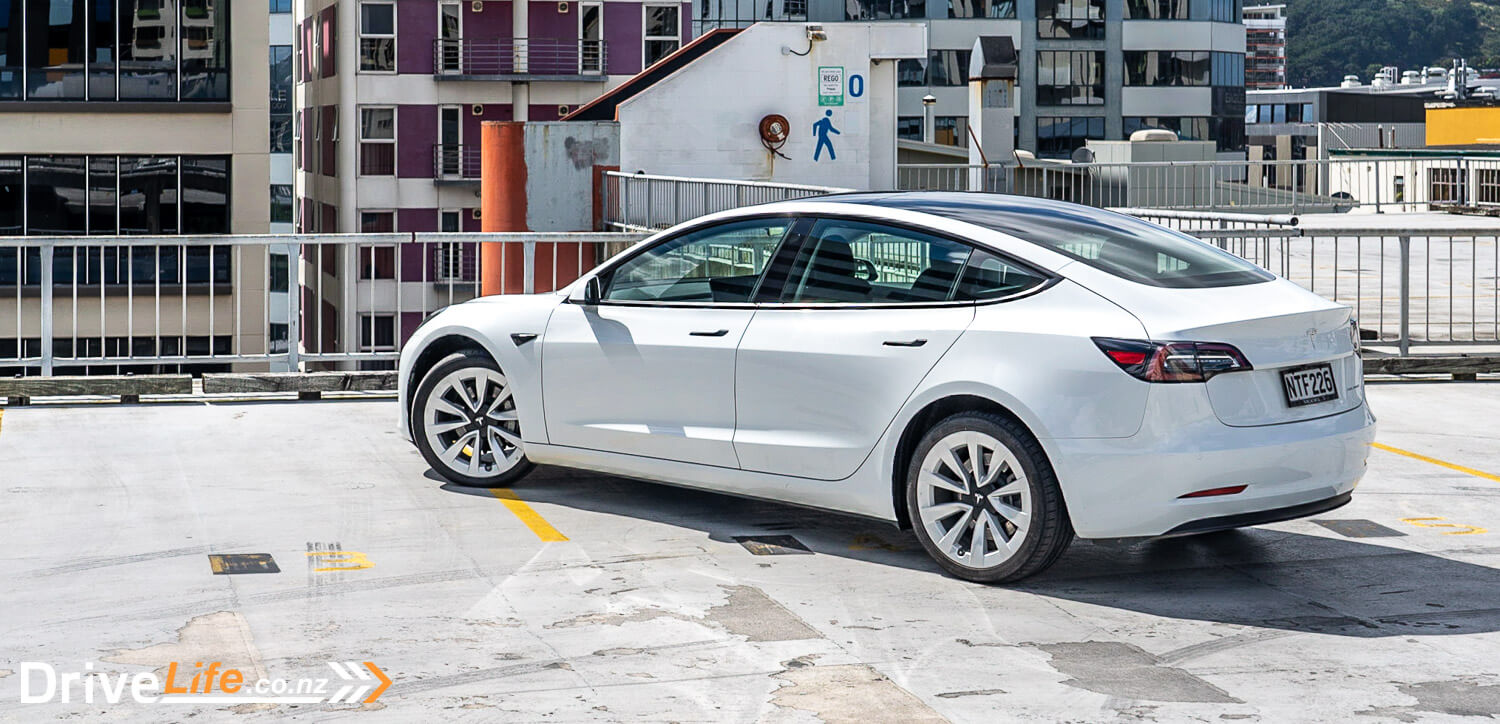
Fit and finish on this Chinese-built Model 3 is a big improvement over the previous (US-built) one we tested, with better attention to detail and more even gaps around trim joins. It actually looks like an $82K car now, with regards to build quality. I still spotted a few panel joins that weren’t perfect, but a massive improvement over our last test car.
It also still turns heads. We’ve had Teslas in New Zealand for quite a while now, but people still look as you drive past. Nowhere near as much as when we were in the Hyundai Ioniq 5, however.
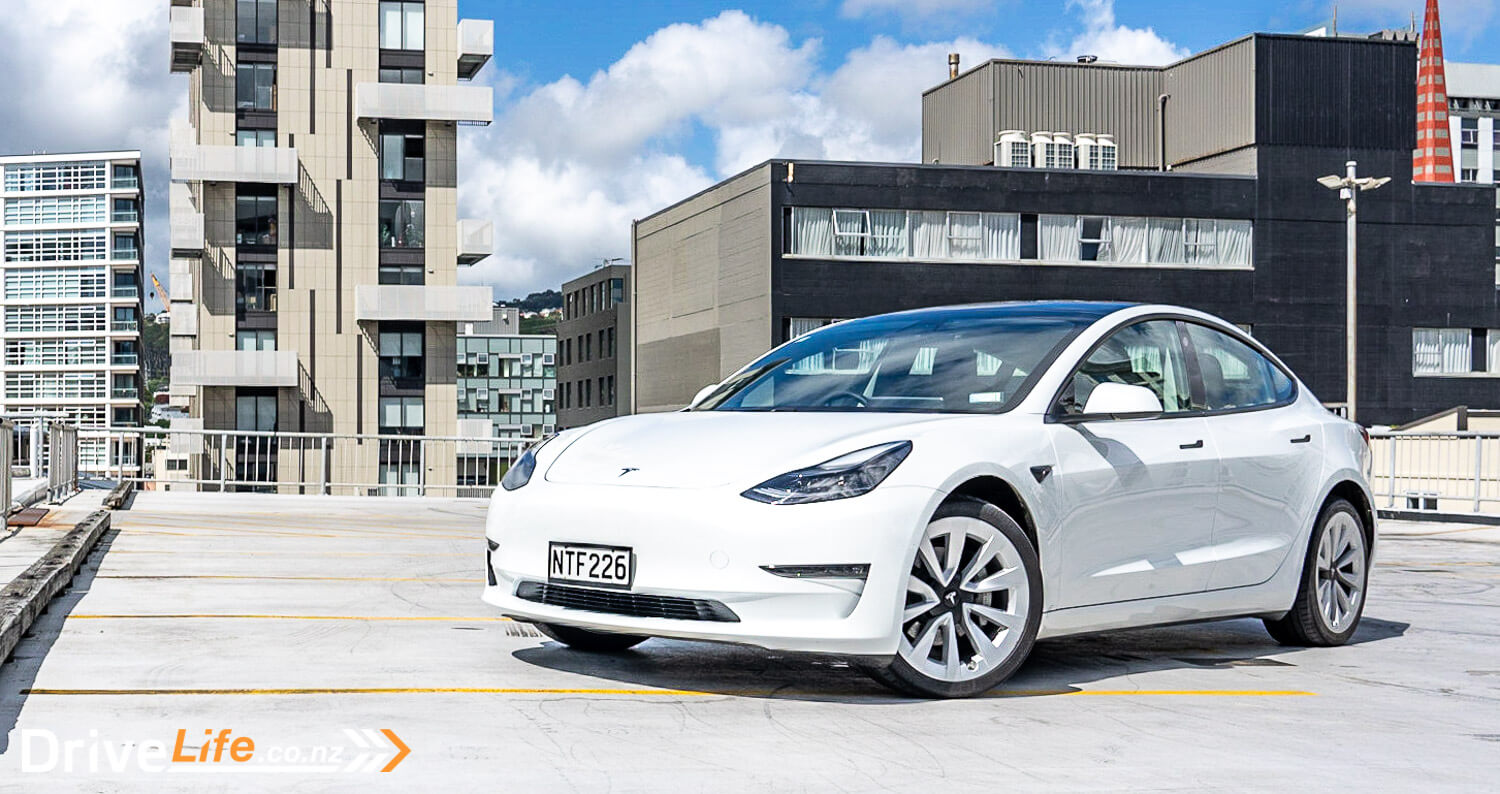
What’s The Interior Like In The 2021 Tesla Model 3 Long Range?
There have been some welcome changes in the interior of the new model, with the piano black console being changed to a new, matte grey to show fewer fingerprints. The sill plates and door handles are changed in trim as well, and I love the new magnetic sun visors that simply lock into place when you get them close enough. No more jabbing around to try and lock the sun visor in its home position, after moving it from the side.
In front, there are now two wireless charging pads, side by side, and this is the first car I have seen this on. I’m really hoping it will become the norm, as I used them both all the time when I had passengers.
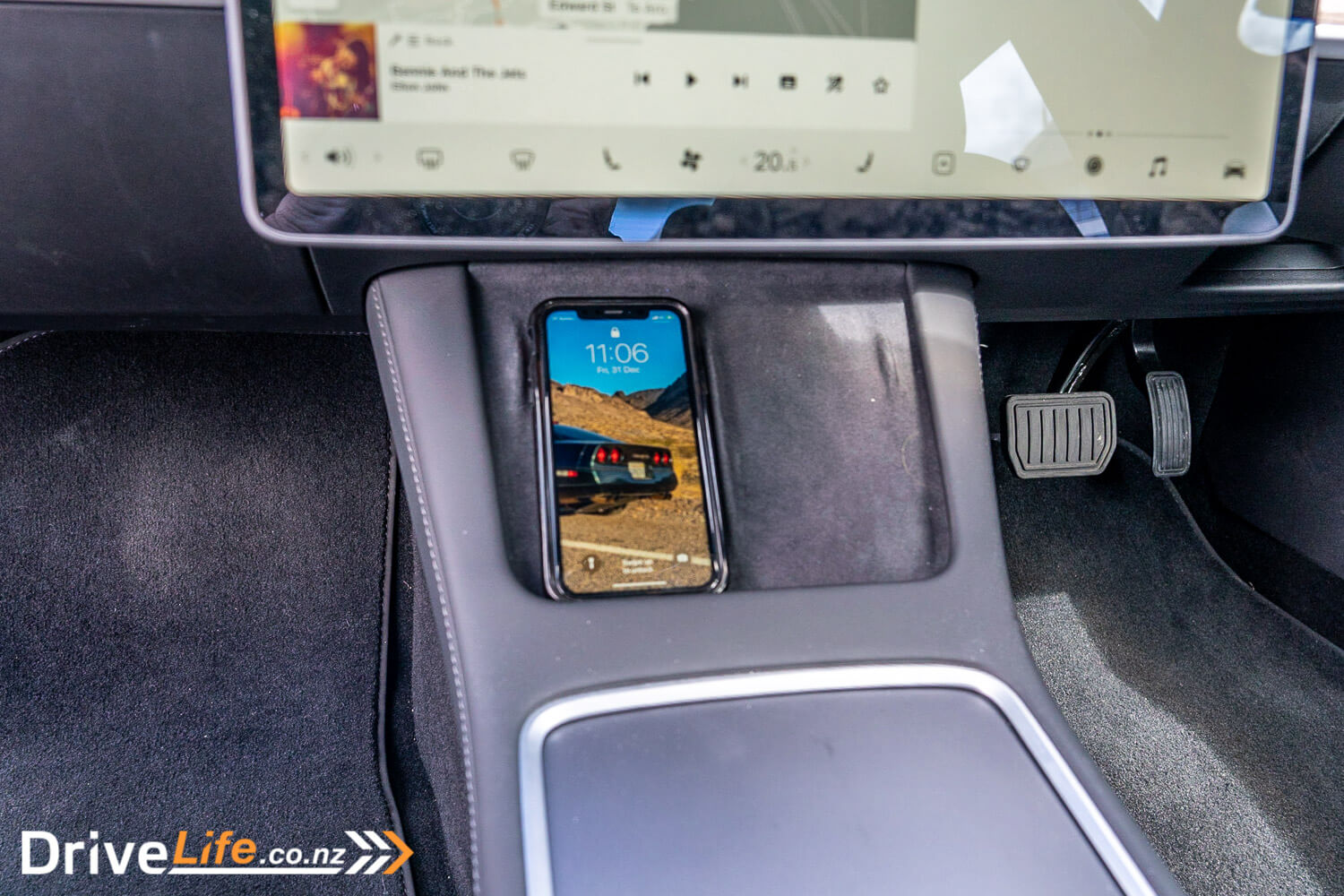
The whole centre console has had a redesign, and it’s a lot more usable now. There’s still a huge cubby up front, behind the wireless charging pads. It’s extremely deep and goes forward as well. Under the armrest is another massive cubby, with 2 USB-C ports in it. This goes under the cup holders and is just as big as the front one.
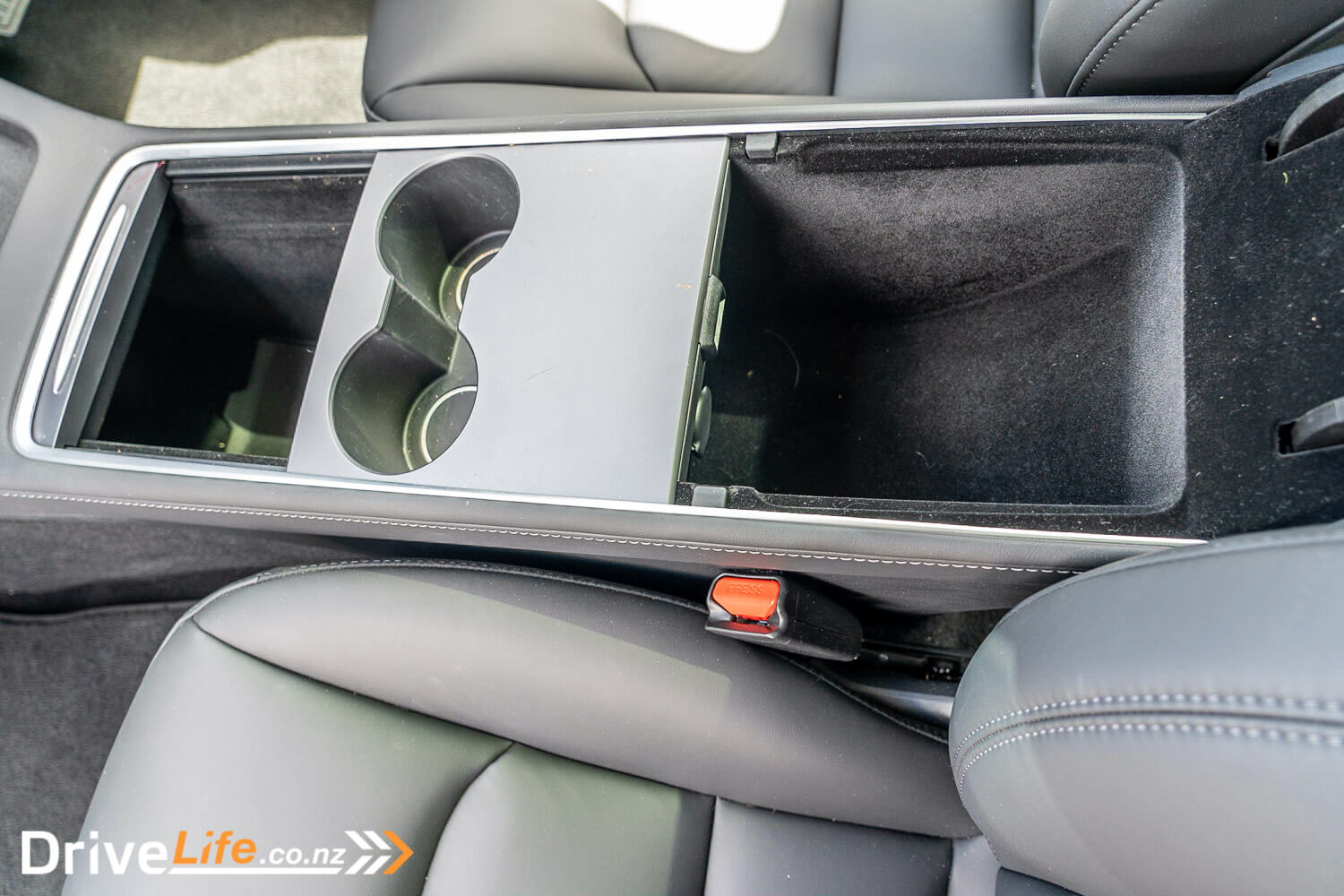
As before, rear-seat passengers are spoilt for both leg and headroom. There is a copious amount of space back there, and like the previous model, the centre console has a cut under it, so your middle passengers have more room for their feet. Simple, yet effective.
Like the previous Model 3 we tested, there are no grab handles for your passengers. I’m not sure about the logic of this, as surely they aren’t an expensive item to include. A number of passengers commented on the lack of them.
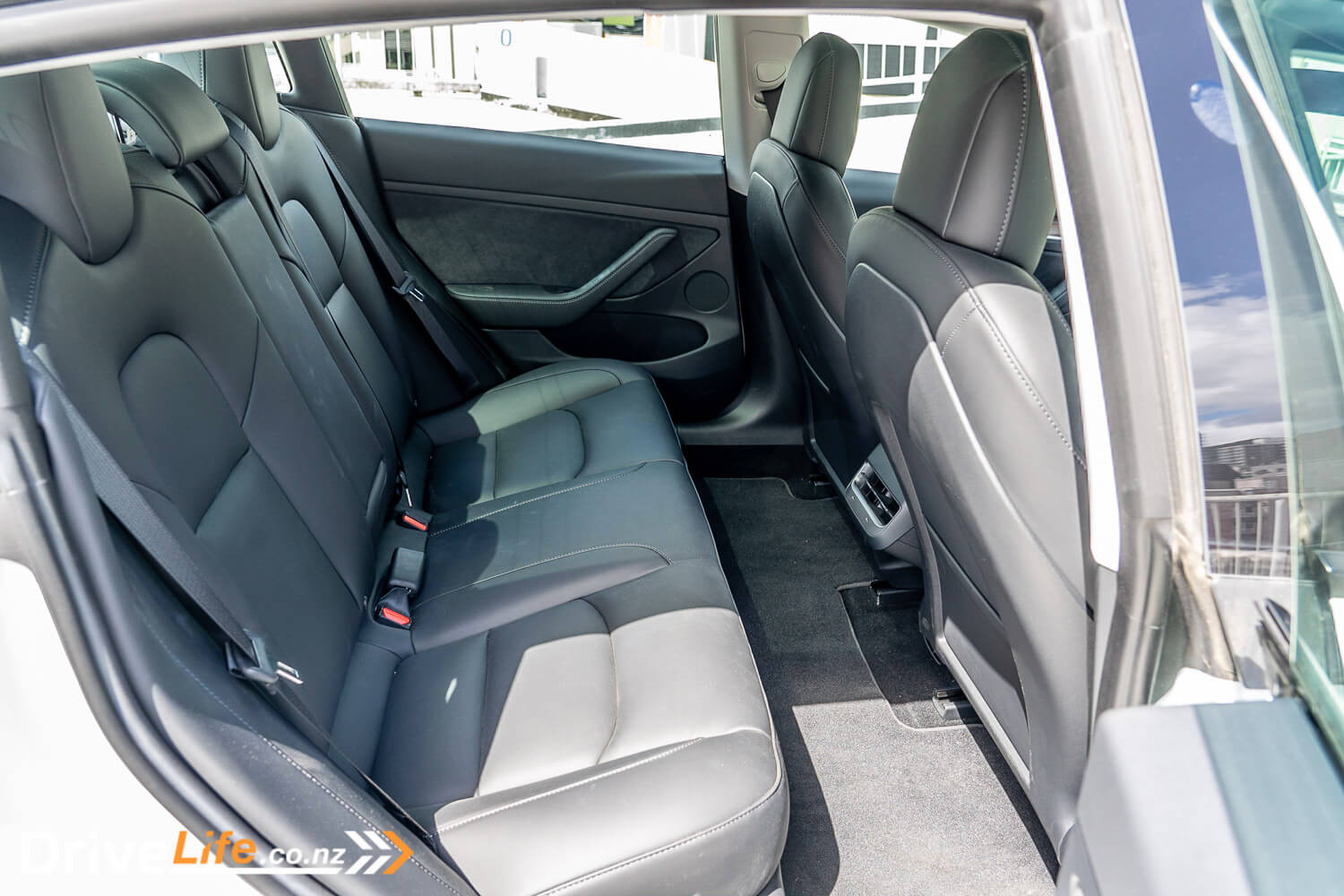
New for this model year is an electric boot lid. There’s a huge boot on the Model 3, and even the dual electric motor (all-wheel-drive) versions have another large area under the floor to store more stuff in. Of course, it still has a frunk and it’s a decent 88 litres in size, far larger than the tiny one on the Ioniq 5. As before there is no spare tyre or any sort of toolkit in the Model 3. If you get a flat you can call Tesla up and they will come and tow you to the nearest place to get it fixed.
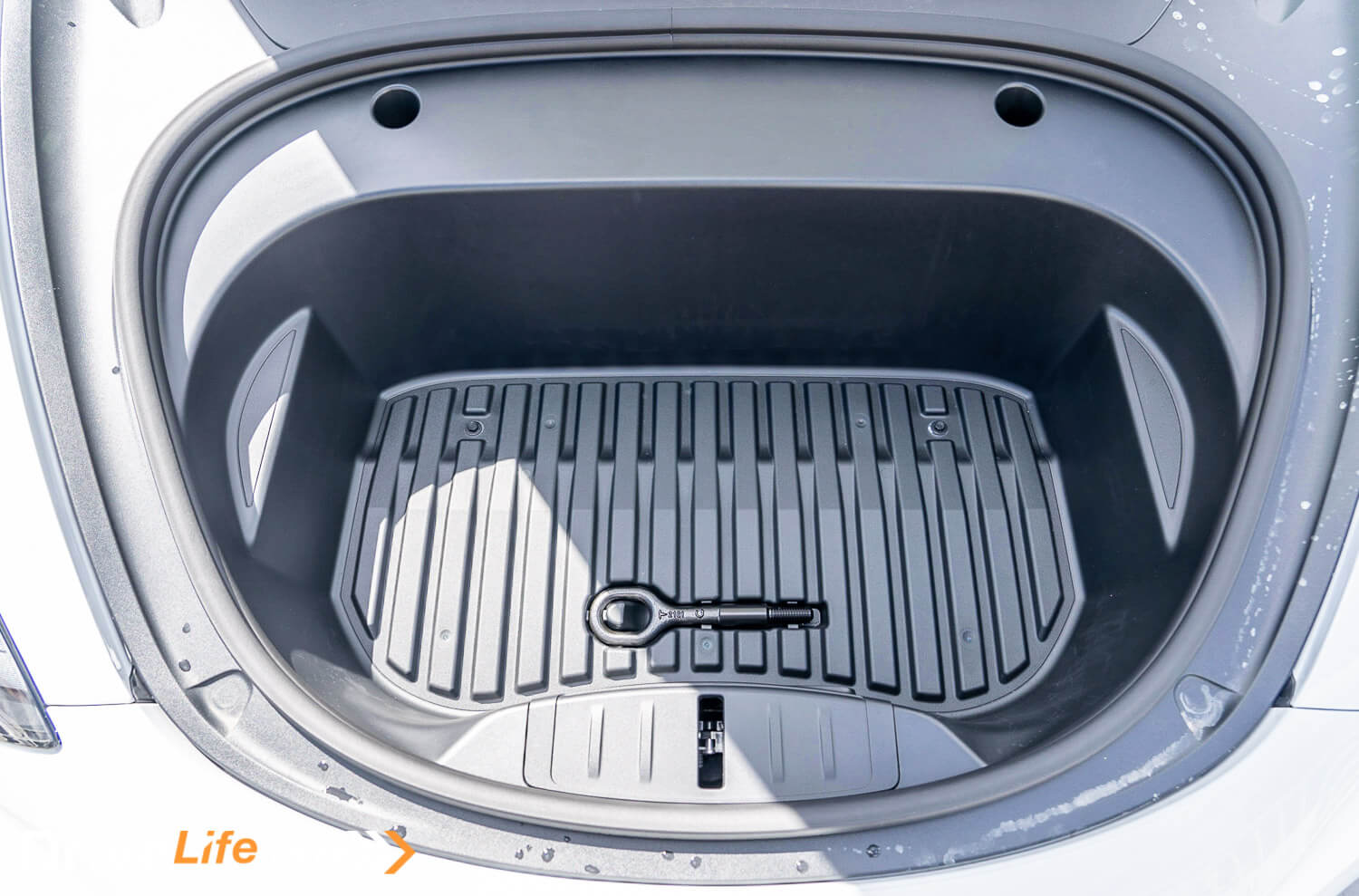
Speaking of the boot lid, the design flaw in this car hasn’t been addressed. You’ll need to be careful if it’s raining, as if it’s raining heavily enough, water running down the back window will go straight into the boot if you have it open. The seal below the back window is too small to stop this from happening, and it’s such an obvious issue I wonder why Tesla hasn’t resolved this yet.
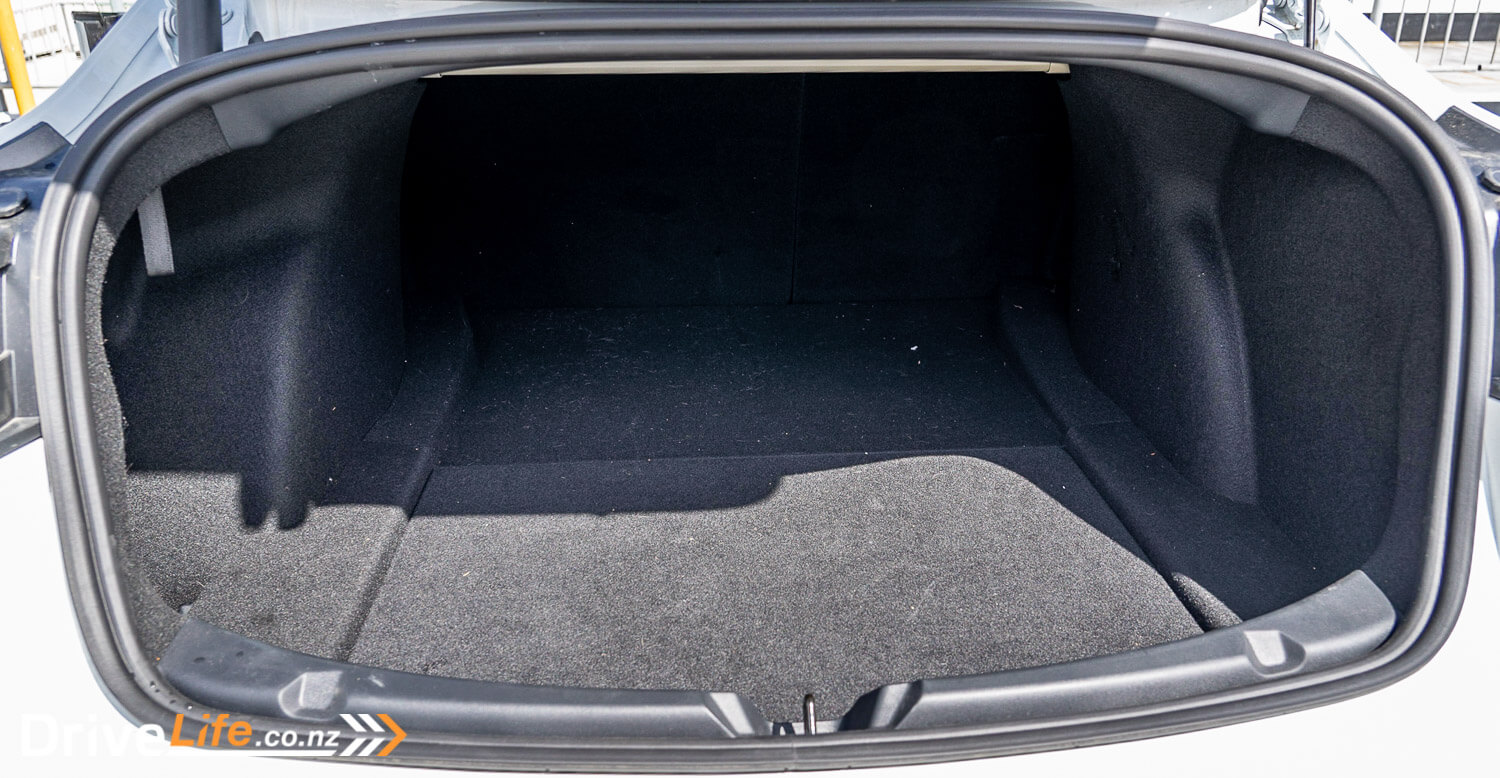
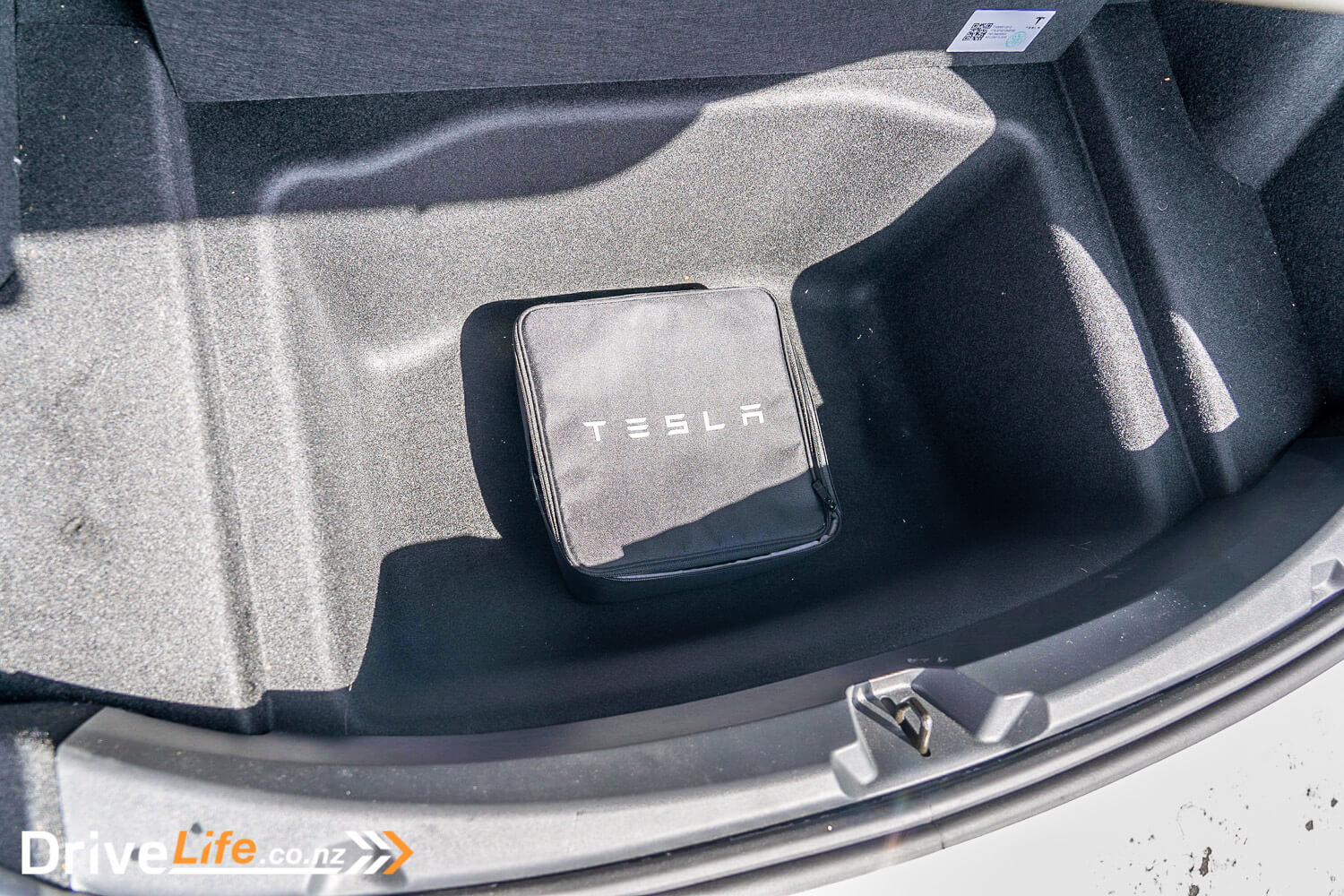
What’s The 2021 Tesla Model 3 Long Range Like To Drive?
While the Model 3 comes with two credit-card-sized keys, once you’ve set up the Tesla app and linked your phone to the car, that’s all you need. Just walk up with your phone in your pocket, and get in. One feature I love about the Model 3 is that there’s no ignition to turn on or off; you simply get in and drive. It’s the same when you leave the car. I had our test car set to auto-lock on walking away, and the auto-locking would also turn the car off. So simple.
With that big glass roof and large side windows, heat can build up on the inside of the car when you aren’t using it. Some days when it was 25 degrees outside, it was over 60 degrees inside. Everything was hot to the touch, and the vegan leather seats felt uncomfortable to sit in. The AC fixed that, but if I were buying any Model 3, I’d spend the $90 on the clip-in blind to try and help reduce those interior temperatures, unless you’ve just moved here from Africa. The glass roof does have infrared and ultraviolet protection, but it’s not enough in New Zealand.
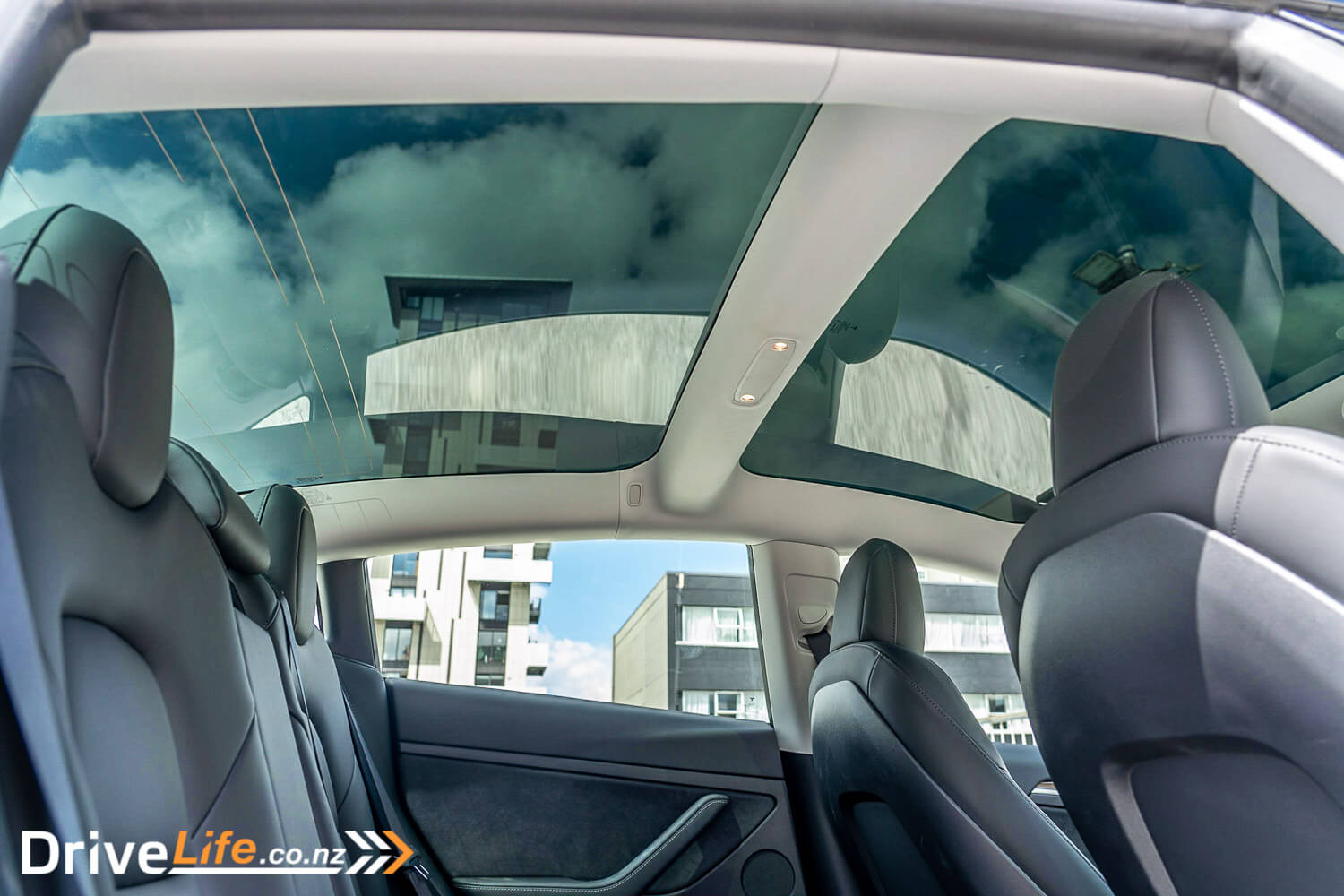
On the subject of aircon, when Rob drove the car last he noted that it seems either too hot or too cold on the car. This hasn’t changed, with the AC in our test car struggling to keep the interior cool. I had it set as low as 19 degrees sometimes, just to try and keep cool. I think part of this may be down to those sexy, full-width air vents stretching across the dash; while you can go into the AC settings on the centre screen and adjust the height and direction of the flow of air, there just wasn’t enough coming out of the vents to keep me cool. Then if I switched the AC to manual and had air coming out for both feet and face, it reduced the airflow too much and didn’t cool me anywhere near enough. Hopefully, we’ll see this fixed on the next release, as it’s one of the things that would put me off buying a Model 3.
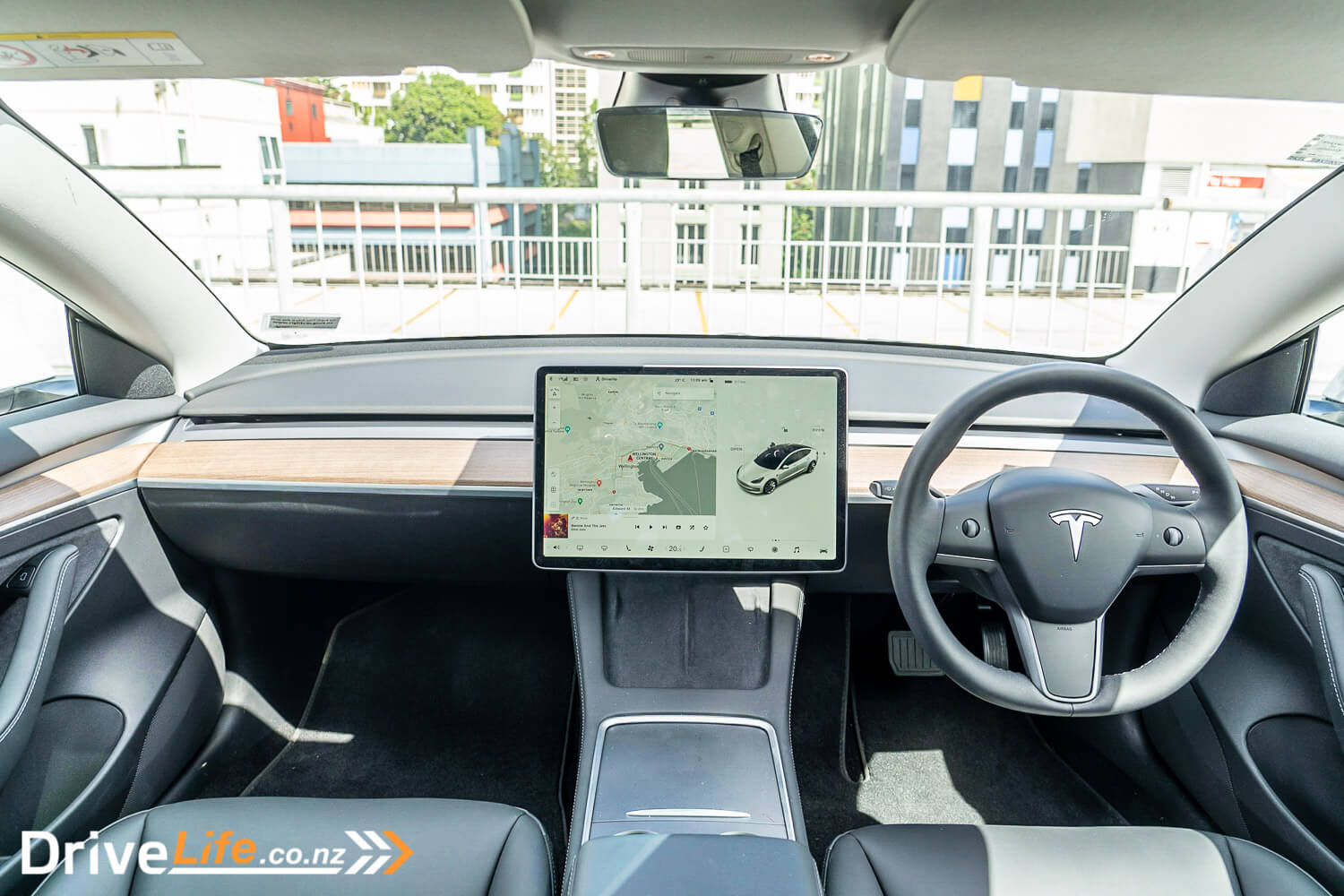
In saying that, I did get into the habit of either setting a scheduled departure time on the Tesla app so it would cool the car down in advance or using the ‘vent’ button on the app which lowers all the windows down a couple of inches. But a blind is still the way to go, better off trying to reduce the interior temperatures in the first place.
This newer model now comes with double-glazed windows and it’s had a huge impact on noise inside the car. Regardless of it being an EV, wind and road noise are now down to very low levels. This is probably the biggest change I noted between this Model 3 and the last one. Those Hankook Ventus ST EVO tyres get a bit vocal on coarse chip seal, but that can be said of most tyres on the market. The bottom line is that the 2021 Model 3 is now almost silent inside.
Rob noted some technical glitches with his 2020 Model 3, as did I. How was our test car over the 1,500Km I drove it? Far better, with no notable issues. Building the cars in China seems to have paid off. Actually, the whole car feels a lot tighter, and the driving experience has improved over the last one I drove. Kudos, China.
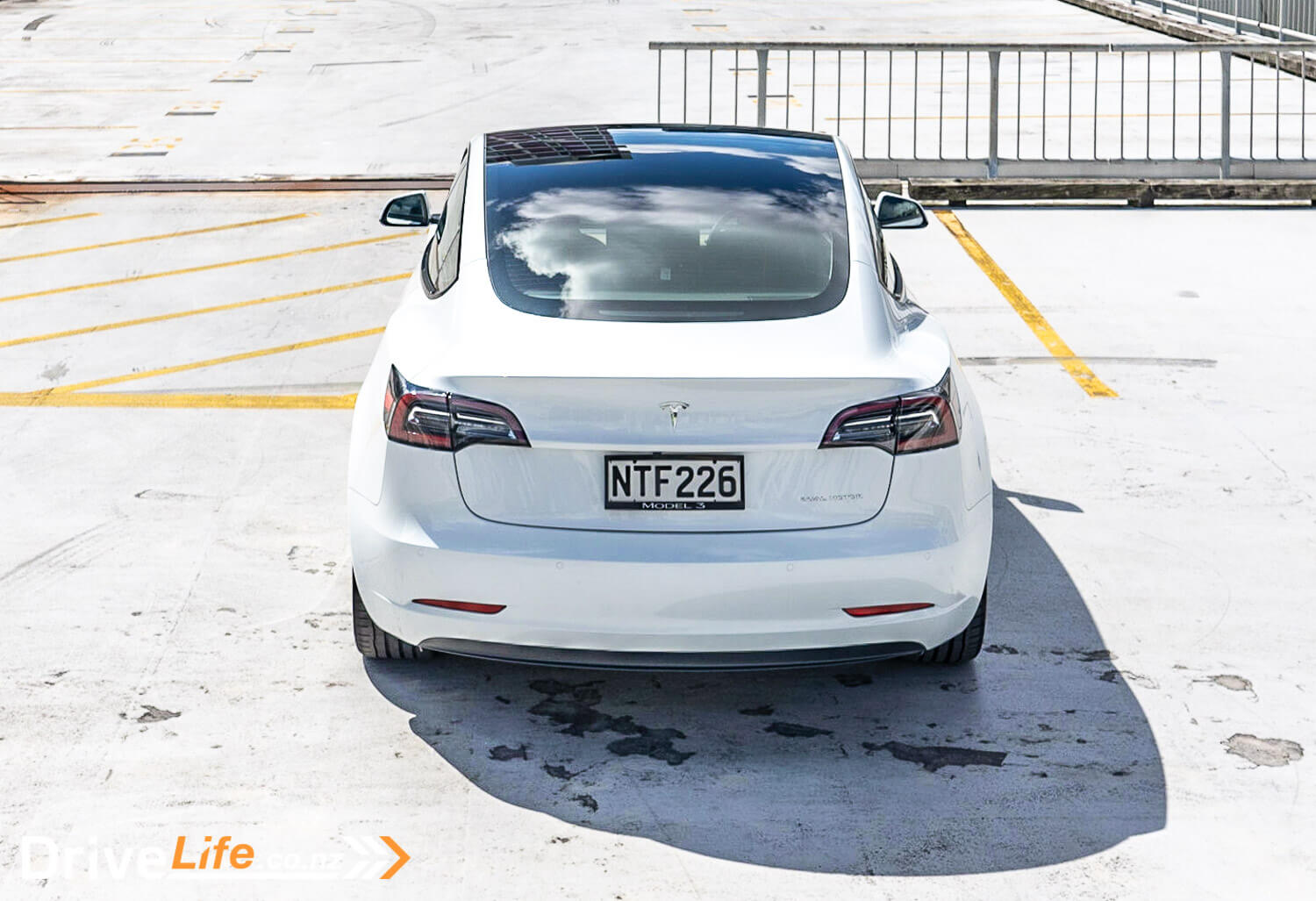
Our test car had no options, although I would have liked to have tested the $11,400 ‘Full Self-Driving Capability’. This is the option that also has Summons mode, which will bring your car to you in a carpark, to save you from getting wet in the rain (for example).
The full package includes:
- Navigate on Autopilot
- Auto Lane Change
- Autopark
- Summon
- Full Self-Driving Computer
- Traffic Light and Stop Sign Control
Tesla says that soon, Autosteer on city streets will be added to the Full Self-Driving Capability package.
While the title says “Full Self-Driving”, it really isn’t. So what does Full Self-Driving actually mean? This is from the Tesla website:
- Navigate on Autopilot (Beta): Actively guides your car from a highway’s on-ramp to off-ramp, including suggesting lane changes, navigating interchanges, automatically engaging the turn signal and taking the correct exit
- Auto Lane Change: Assists in moving to an adjacent lane on the highway when Autosteer is engaged
- Autopark: Helps automatically parallel or perpendicular park your car, with a single touch
- Summon: Moves your car in and out of a tight space using the mobile app or key
- Smart Summon: Your car will navigate more complex environments and parking spaces, manoeuvring around objects as necessary to come to find you in a parking lot.
- Traffic and Stop Sign Control (Beta): Identifies stop signs and traffic lights and automatically slows your car to a stop on approach, with your active supervision
“While using Autopilot, it is your responsibility to stay alert, keep your hands on the steering wheel at all times and maintain control of your car.” You can read all about Autopilot and the Full Self-Driving capability here.
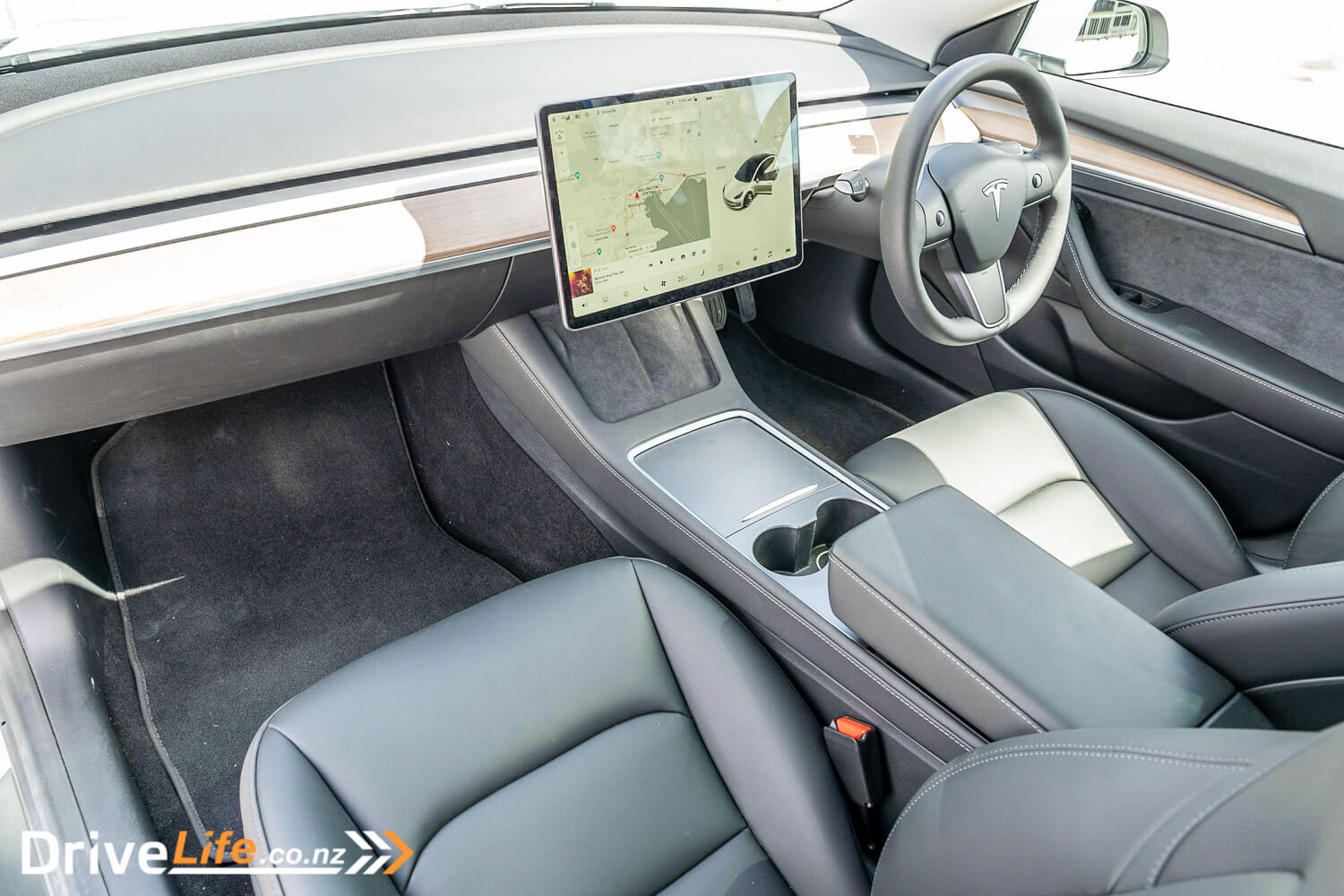
To buy the Full Self-Driving Capability package, a Tesla owner simply ticks a box on the Tesla app on their phone, pays, and then the packages will be installed over the air – so there is no need to go to a Tesla shop to get anything done.
What Happens If You Sell Your 2021 Tesla Model 3 Long Range With An Optional Package?
We get a lot of questions around buying the Full Self-Driving Capability packages, or any other package a Tesla owner might purchase over the air. What happens when the car gets sold? Does the new owner get the package, or does the package stay with the person who paid for it? According to Tesla New Zealand, any package purchased over the air belongs to the car, and not the account holder. This means that if I buy the Full Self-Driving Capability package and then sell my Tesla, that package will stay with the car, end of story.
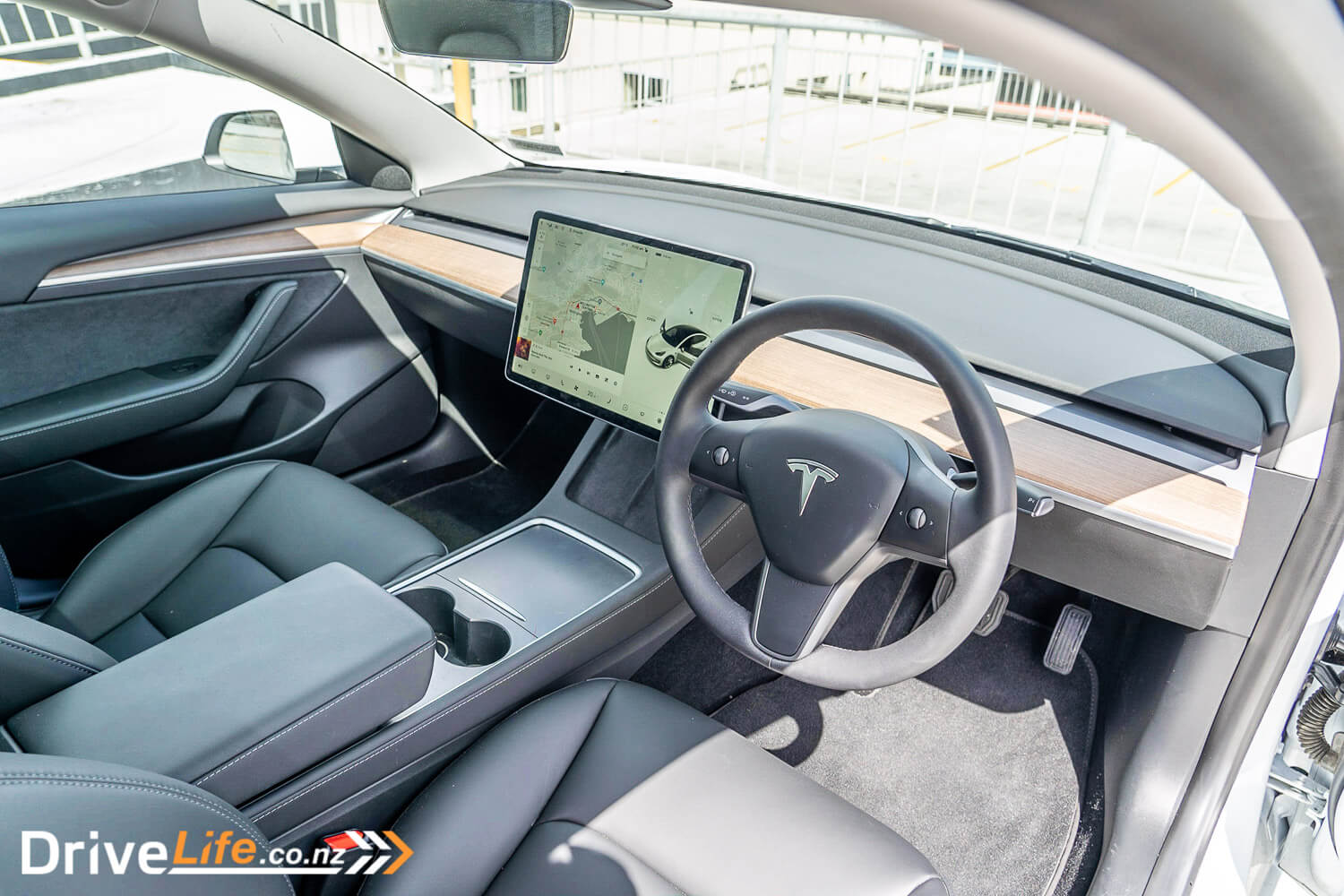
Still, the standard adaptive cruise control (Autopilot) is still one of the best, and I used it often. Since your speed is only shown on that centre screen and the digits are not that big, it seemed prudent to use adaptive cruise to save getting parking tickets. On speaking with another Tesla owner, he did the same thing for exactly the same reason. Oh, for a heads-up display in the Model 3. Alas, at $83K, it doesn’t have one and it’s not even an option. It’s not even fitted to the $95,900 Performance model, and that’s very surprising.
All Model 3s have the Autosteer function, which will assist the driver to stay in their lane, essentially steering the car for you, but you need to keep your hands on the wheel at all times of course. It’s still one of the best, and other than a few times passing through Patea where the car wanted to turn into a side road, it was near-on faultless. It really is the benchmark for self-steering systems.
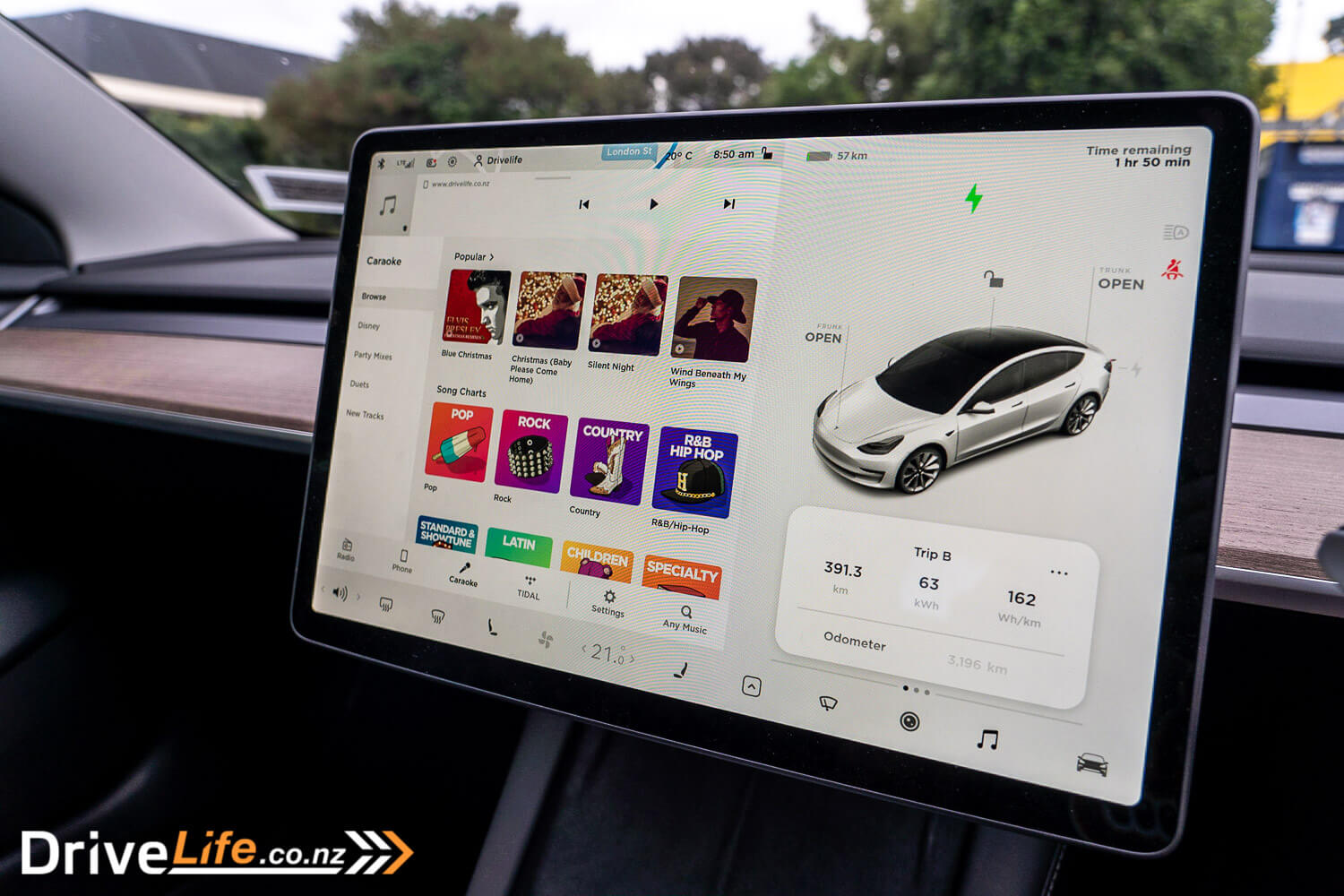
Adaptive cruise will set the car’s speed to whatever speed you are driving, but if you tap down on the gear stalk again, this will turn Autosteer on. Autosteer will maintain the speed you have set, but if the speed limit changes and goes down, it will automatically change your set speed down to the new limit. Nice! It won’t go up though, so if you change speed limits up, you’ll need to tap the new speed limit on the centre screen to set it higher. The only issue with this is the traffic sign recognition in the new model. It’s a bit flaky at times, and simply won’t read overhead gantries on the motorway. I found this very surprising, as Tesla generally has been the trendsetter for traffic sign recognition.
You kick-off voice recognition by pushing in the right-hand knob on the steering wheel. Generally, it’s pretty good, but it did struggle sometimes with my accent (I have an accent?). For example, I tried three times to say “Navigate to Eastern Hutt Road” and it came out 3 times as Easton Heights Road. I gave up at that point. Otherwise, the voice recognition system was eerily accurate, and i used it often, rather then (for example) searching through menus on the screen to do something. You can simply say, “Open the glovebox”, and it opens. A cool party trick. Other party tricks include Fart Mode, and CARaoke, which Rob covered in his review.
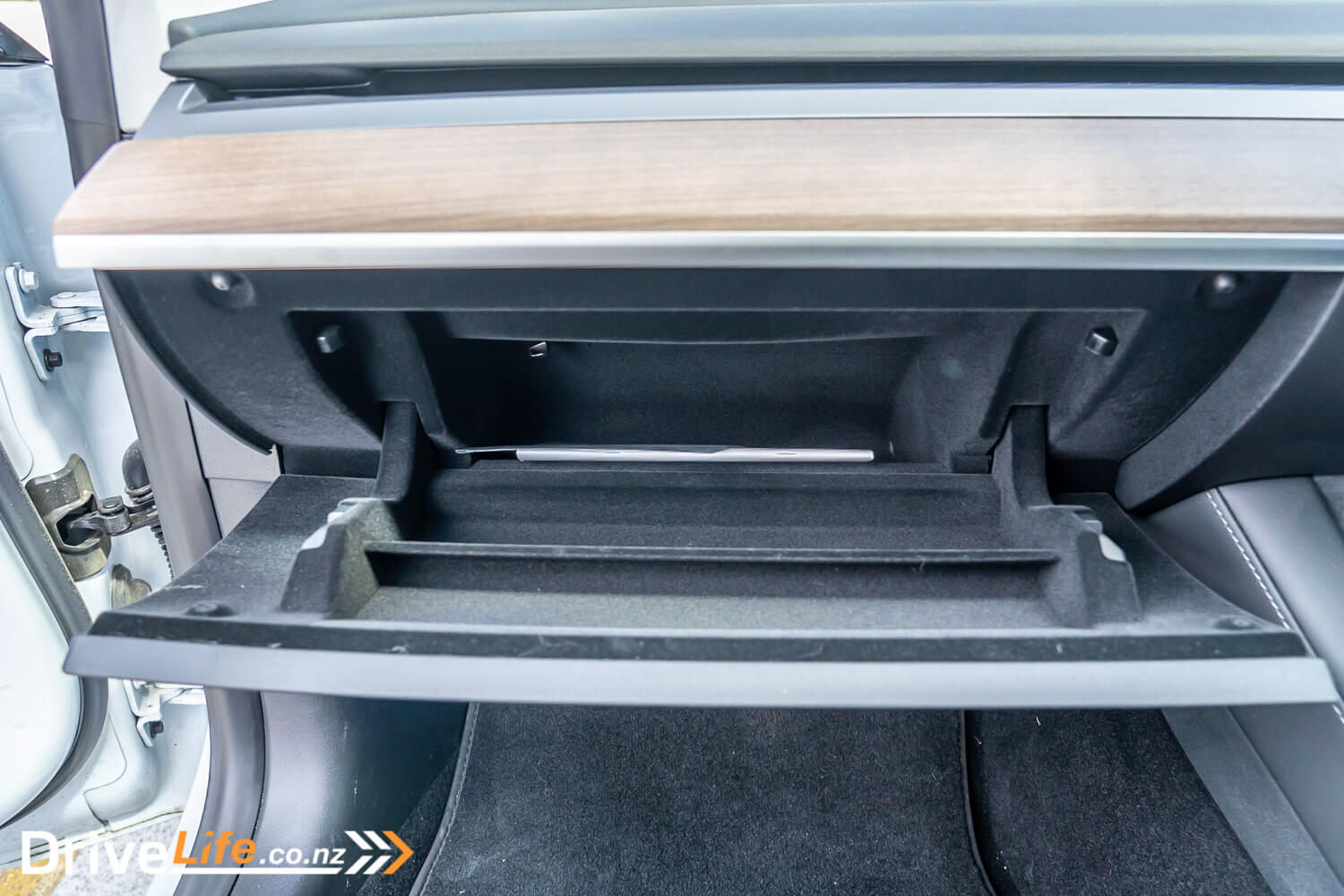
While I was testing the Model 3 Long Range, it was time to head to Hawera as part of our Project V8 Sunbeam Rapier Fastback. This meant a 574Km round trip, perfect for seeing just how close we can get to Tesla’s range figures for this model.
The WLTP range on the 2021 Tesla Model 3 Long Range is 614Km. On the dash, there is a range meter that can be switched between % remaining in the batteries and Km you can drive. With this 614Km range in mind, I fully charged the Model 3 Long Range at home and set off for Hawera, a 297Km drive one way. The dash showed me 545Km of range, so I was hoping I’d at least get close to this.
I hit the road at 6am, and used Autopilot nearly the whole way, and it was an effortless drive, although the lower-rear of the seat felt like it was pushing in on my back too much, even with lumbar adjust backed right off. I notice that Rob mentioned this same thing on his drive on this same route in 2020.
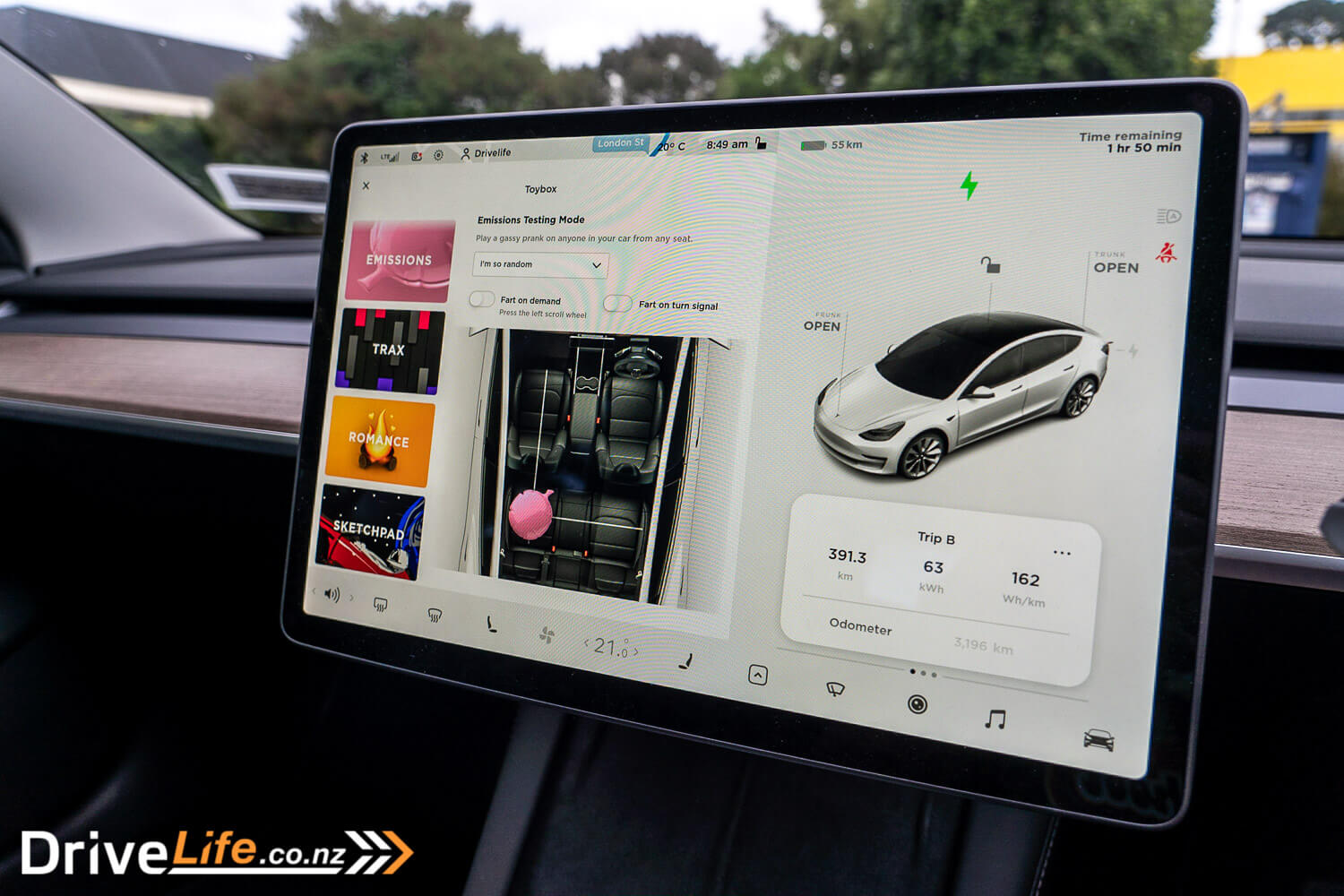
I also notice other Tesla drivers are a friendly bunch, almost all of them waving as they drive past me. Nice. Four hours later, I arrived in Hawera with 190Km range left (34%), and 289Km driven at 16kWh/100Km. That’s a very reasonable number, and a little less (better) than we got from the Hyundai Ioniq 5 recently.
After a night’s stay in town, I left Hawera in the wet, now with 23% left and SatNav showing me arriving at the Tesla Supercharger in Palmerston North with -13% battery left. That meant a Plan B, so I decided to stop in at Whanganui on the way, a drive of 67Km. The Model 3 said I should arrive with 3% battery left. Challenge accepted!
In fact, I did arrive with 3% left at Pak ‘n Save Whanganui, plugged into the Chargenet charger and paid 25cents per minute and 25 cents per kilowatt/hour to charge. It would have taken 2 hours total charge time charging at 240Km charge per hour, but at 31% and now with 175Km range, I stopped charging, paid my $13.44 and hit the road to Palmerton North.
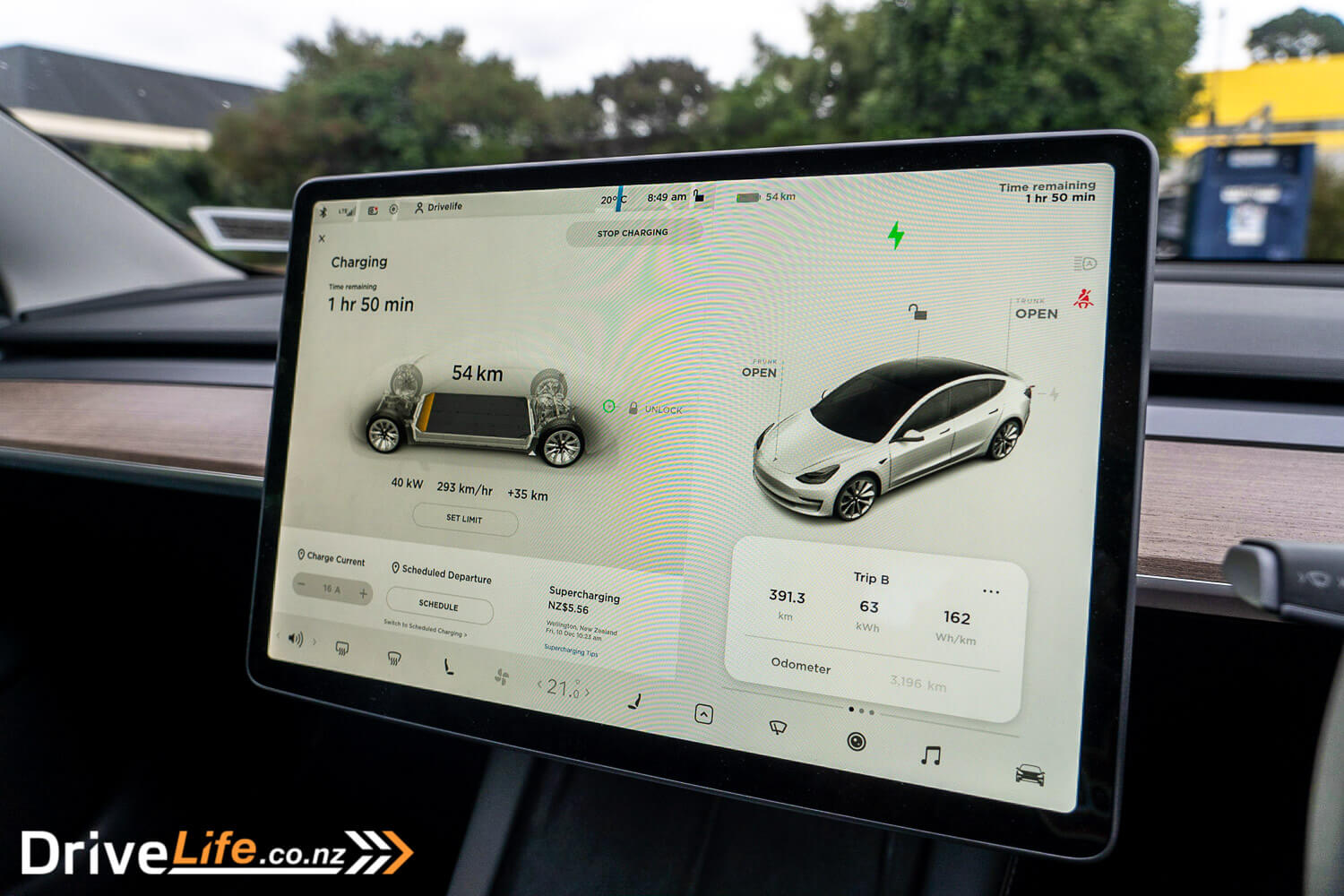
I didn’t really need to go to Palmerston North, as I could have simply stayed in Whanganui and charged up enough to get back to Wellington, but decided to drive to Palmy for two reasons:
1: I’ve never had to use a Tesla Supercharger
2: It would be free to charge up (for our test car)
It’s a 90Km drive to the Supercharger, and ten minutes from Palmerston North the display changed to say it was now pre-conditioning the batteries in preparation for using the Supercharger. How cool is that?
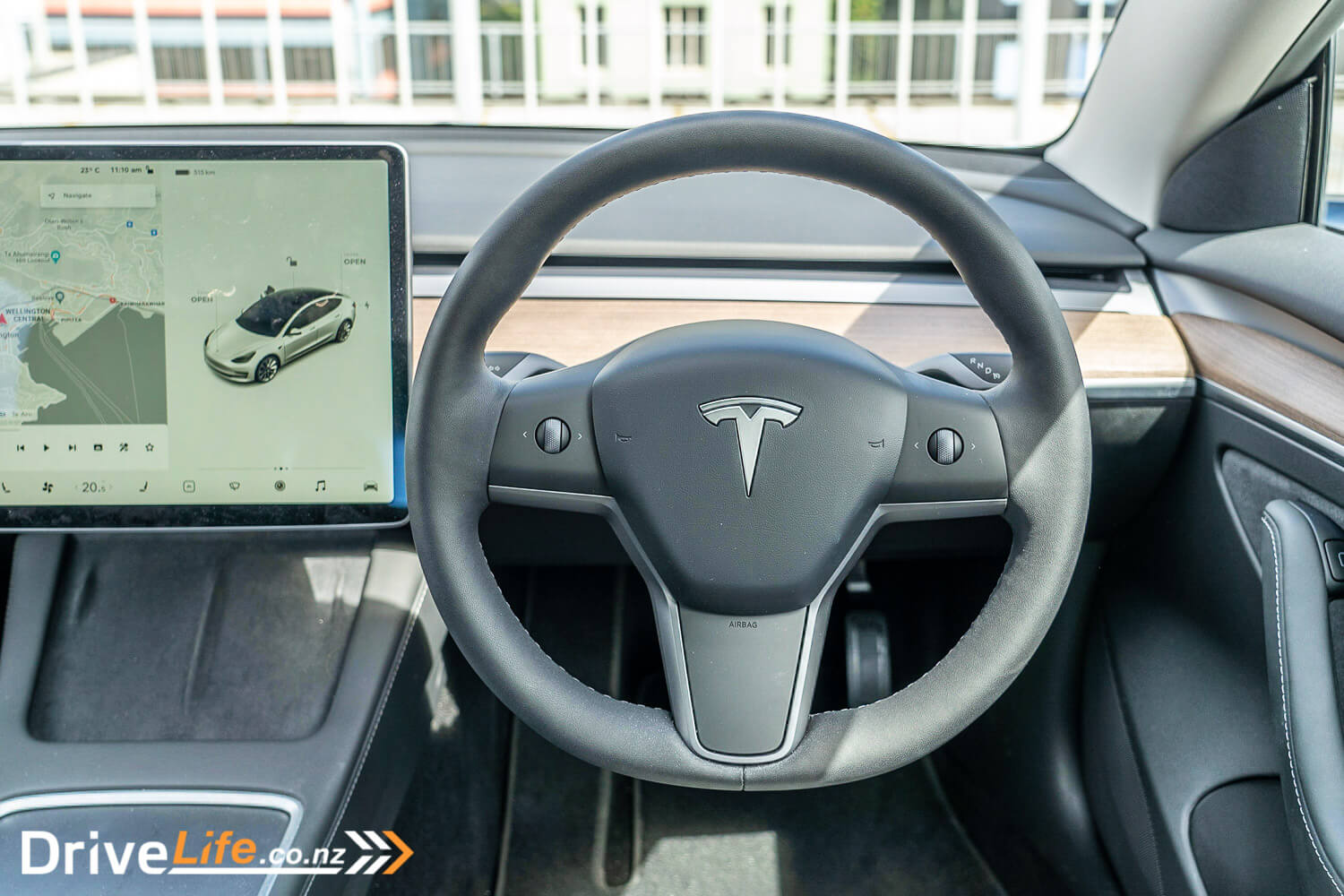
I’ve got to say even with the SatNav directions to the Supercharger, I struggled a bit to actually find it. After asking someone working in the car park where the Superchargers are located, they were there, but not obvious until you get right to them.
After plugging in, the charging started all by itself, putting in 920Km/hour of charge. Compare this to the 240Km/hour at the Chargenet charger, and I’m getting almost four times the amount of charge. At 50% charged, this dropped to 745Km/hour. Still, after 20 minutes I had easily enough charge to get home, and I hit the road. Generally, for most Tesla owners to use a Supercharger they pay between 40 cents and 80 cents per kilowatt/hour of charge. You can read more about Tesla’s Superchargers on this link.
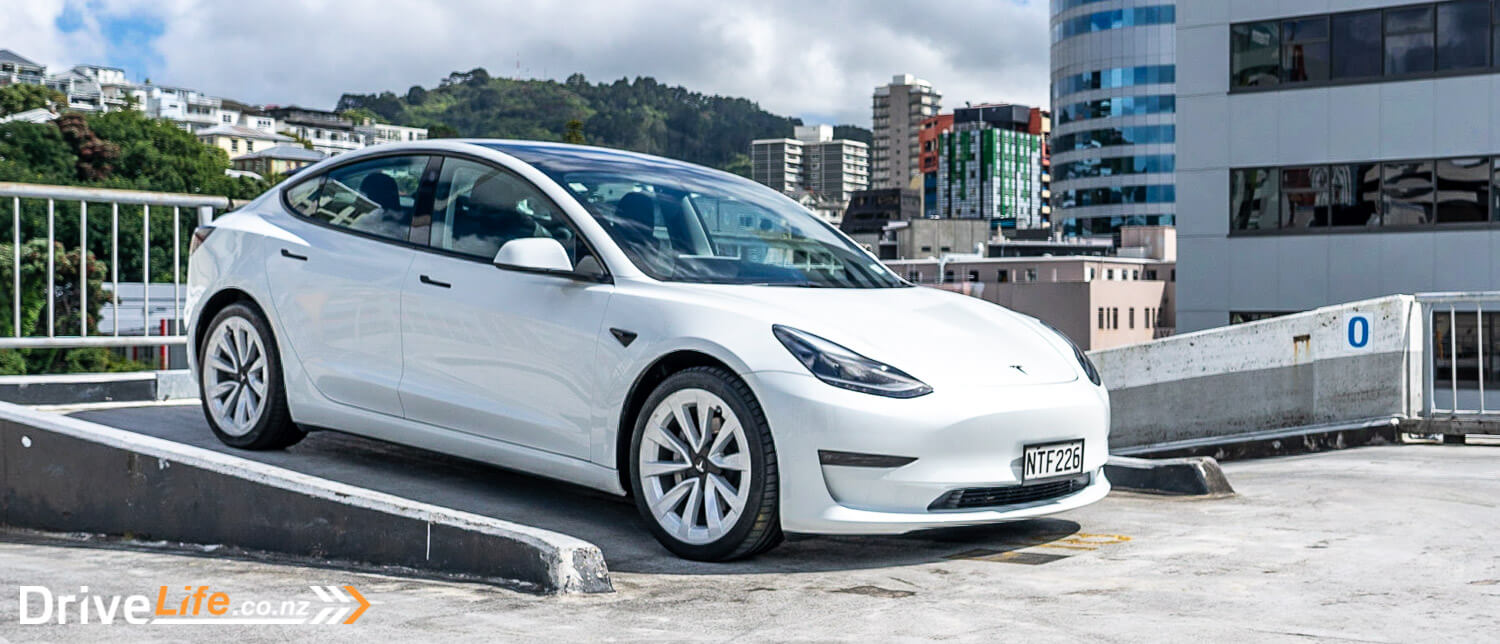
I didn’t get the 553Km suggested range that the car told me or the WLTP figure of 614Km for the Long Range mode. Instead, I got around 477Km. In the scheme of things, this wasn’t too bad. We rarely match a manufacturer’s figures for a petrol or diesel car either.
Reflecting on my 550Km trip, the quality of the ride in the Model 3 Long Range is a stand-out; it’s superb, as is generally handling and steering. The steering feel is a little lacking, but it’s a very quick steering system at 2 turns lock-to-lock. Overall, I covered 1,500Km in the Model 3 Long Range, and it averaged 16.0kWh/100Km, a little less than the 16.5 suggested by Tesla.
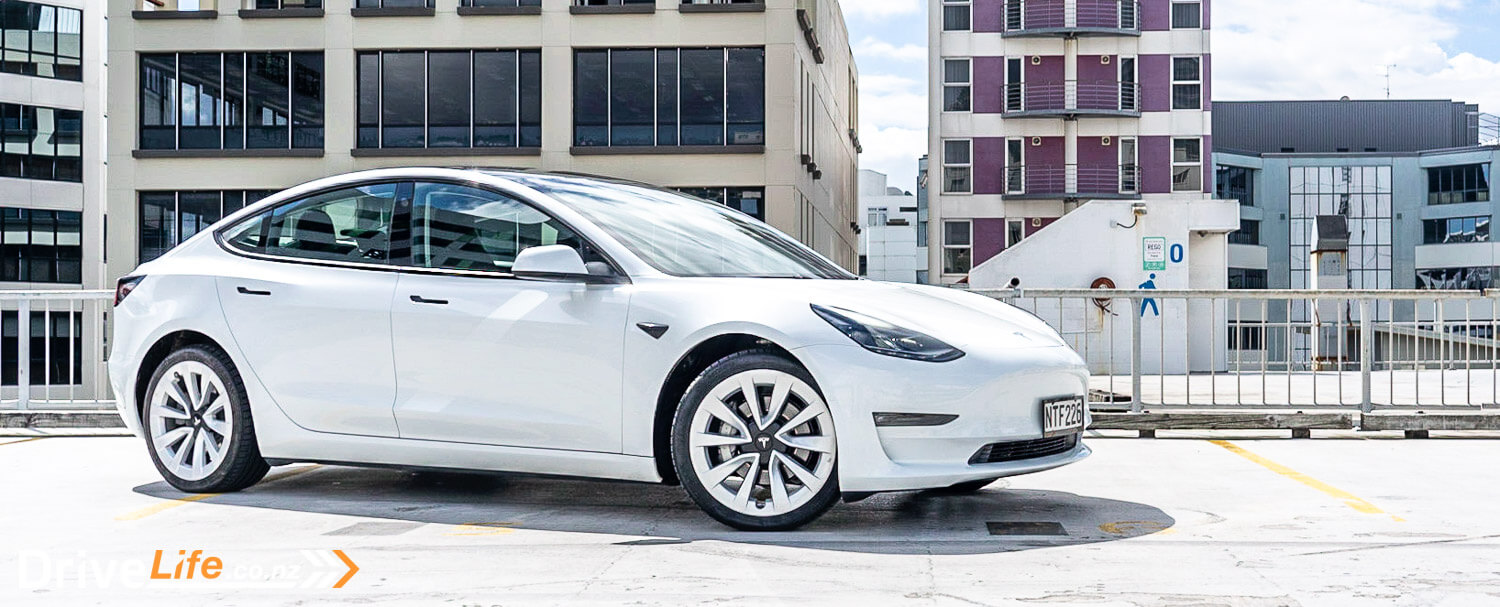
Tesla Model 3 Long Range – Specifications
| Vehicle Type | Electric, all-wheel drive, 4-door sedan |
| Starting Price | $82,990 |
| Price as Tested | $84,932 |
| Engine | Dual electric |
| Power, Torque kW/Nm | 258/510 |
| Transmission | – |
| Spare Wheel | None |
| Kerb Weight, Kg | 1,684 to 1,931 |
| Length x Width x Height mm | 4694x2088x1443 |
| Cargo Capacity, Litres | Front trunk: 88 Boot: 561 Total: 649 |
| Battery type | Lithium-ion |
| Battery Capacity kW-hr | 75 |
| Energy Economy, kWh/100km | Advertised Spec – Combined – 16.5 Real-World Test – Combined – 16.0 Low Usage: 6-10 / Medium Usage 11-19 / High Usage 19+ |
| Towing Capacity Kg, unbraked/braked | Not permitted |
| Turning circle metres | 11.6 Small: 6-10m / Medium 10-12m / Large 12m+ |
| Warranty | 8 years or 192,000 km, whichever comes first, with a minimum 70% retention of battery capacity over the warranty period. Warranty information is here. |
| Safety information | ANCAP Rating – 5 stars Rightcar.govt.nz – 5 Stars – NTF226 |


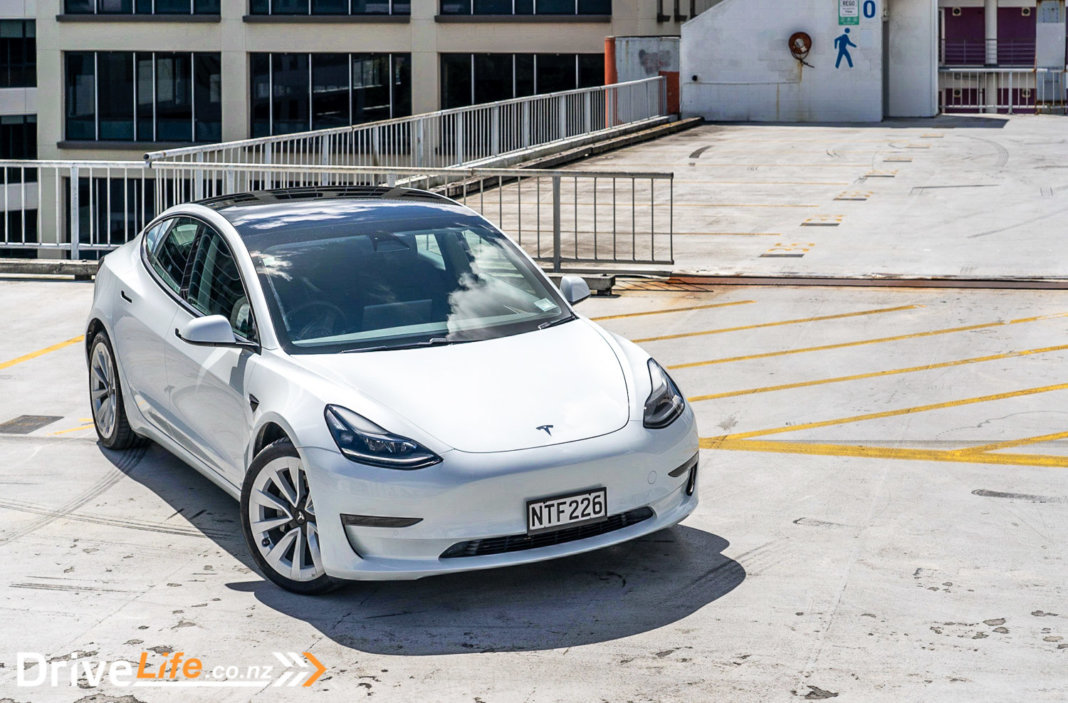











































3-year Tesla owner here. This is an excellent comprehensive review, one of the best I’ve ever read for facts, impressions and fair comparisons. 10/10. Can I nitpick one repeated error; please stop referring to charge quantity as “kilowatts” when the correct term is “kilowatt hours”. Kilowatts refers to the rate of charge (power), whereas kilowatt hours is the quantity of charge (energy). OK, I’m a geek, but this is important, rather akin to reffering to speed as kilometres, rather than kilometres per hour.
Hi Tim
Thanks heaps for the praise, and the correction. I’m not sure what happens in my brain sometimes, but I often forget to add the /hour to kilowatt, so thanks for picking that up. I’ve made the corrections.
Cheers!
Fred
Couple comments about the air con..
There is an option to keep the interior below 40 degrees (I believe it turns the air con on – never actually seen it in action). Practically for me this has meant the interior will get to a maximum of 38 degrees (as can be seen on the app). The air con can be turned on with the app so if you do so 5-10 mins before departure it will easily be sub 20.
Secondly 19 degrees is not cold at all. I believe it bottoms out on “LO” and the lowest numbered temp is 15.5. On a hot day I would only consider 19 if I had been blasting cold for 20 mins and it became too cool.
Third, the air flow is configurable much like any car to have face only, face and feet, feet only etc. There is also a button to toggle rear seat air con – if this is turned on air flow to the front is significantly reduced.
Fourth, if the AC setting is off then it won’t cool much either. I accidentally turned this off once and wondered why it wasn’t cooling down – air was still blowing, just not cold.
Finally, even with air con cranking on cold, yes the sun roof can get quite hot a radiate heat for a long time.
HI Ben
Thanks for the comments. I’ll check the interior temp option next time we get into a Tesla, thanks. 19 is pretty cold! Most cars are set around 23/24 degrees. If I drive around with a car set to 19 degrees, that’s far too cold for me.
I did adjust the flow of the AC, as mentioned.
I also checked the AC is on, would feel pretty stupid if it was off, so before writing about this I made sure it was actually on.
On talking to other Tesla owners, they have the same issue so I felt comfortable that it wasn’t just me.
Still love the car 🙂
Cheers
Fred